Reinventing Radio
Enriching Broadcast with Social Software
Overview
This is a transcript of the IT Conversations presentation of “Reinventing Radio,” a presentation by the BBC at the O’Reilly Emerging Technology Conference 2005. Most of the transcript was written in November and December 2005, and I recently had reason to finish it, clean it up and publish it. The entire talk is here, but the formatting and punctuation are in progress (February 21, 2012).
Other coverage of this particular talk included Joho the Blog; Paul Hammond’s own coverage; Tom Coates’s own coverage, his Phonetags discussion and his followup on the original presentation; and the PDF the slides integrated into this transcript are from.
For my own part: I did not attend ETech’05. I heard the talk as a podcast during my commute to work and remember being slack-jawed the entire time. I felt the work of these four people was years ahead of the industry, as they were talking about work they had done the year prior, and it changed the way I thought about software and social software. Their research and ideas are still reflected in my work today, and I believe still applicable and underutilized in many other industries.
They all eventually left BBC R&D, all continued to do fascinating things, and I have followed them with rapt interest ever since.
Transcript
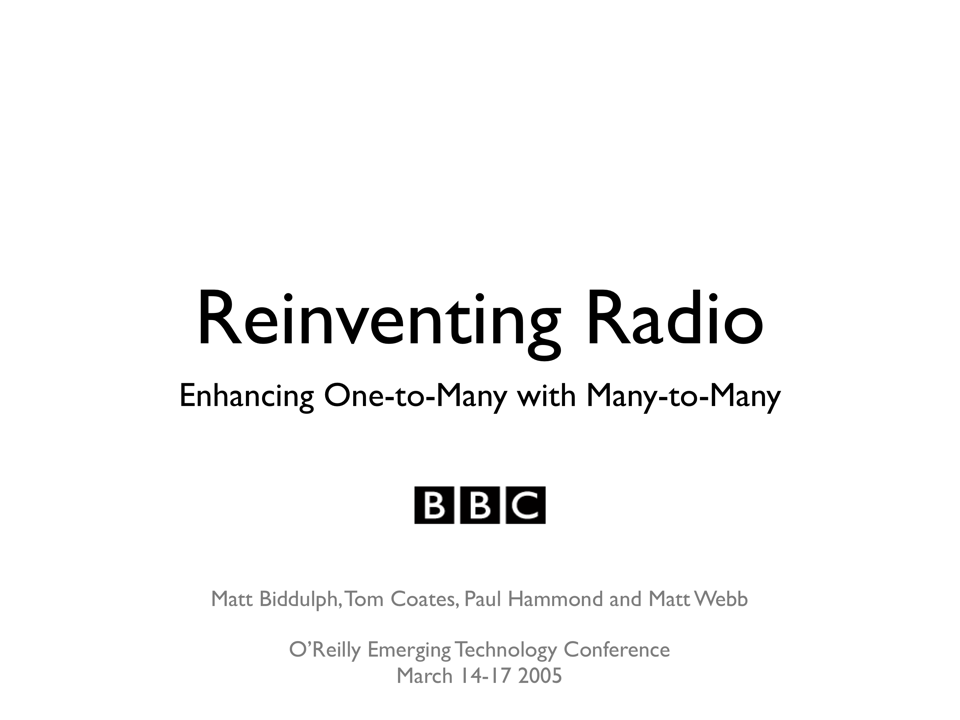
Hello everybody, my name’s, uh, Paul Hammond (@ph), to my right is, uh, Tom Coates (@tomcoates), Matt Biddulph (@mattb) and Matt Webb (@genmon), we're from the BBC and we’re here today to talk about radio.
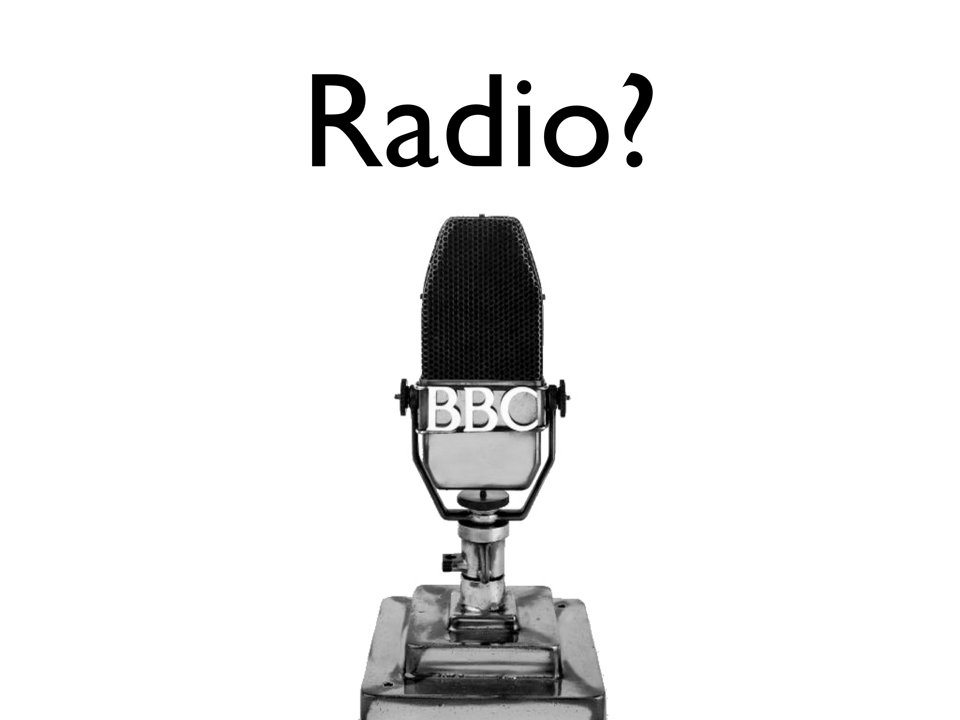
So, there’s, uh, probably a couple of people in the audience who, uh, sat there thinking, “Why on earth are we here at a conference about new, exciting, innovative technologies, talking about something old and boring like radio?” And, so, we’re going to get on to that in a moment, but first of all, I want to explain a little bit about the cultural significance of radio.
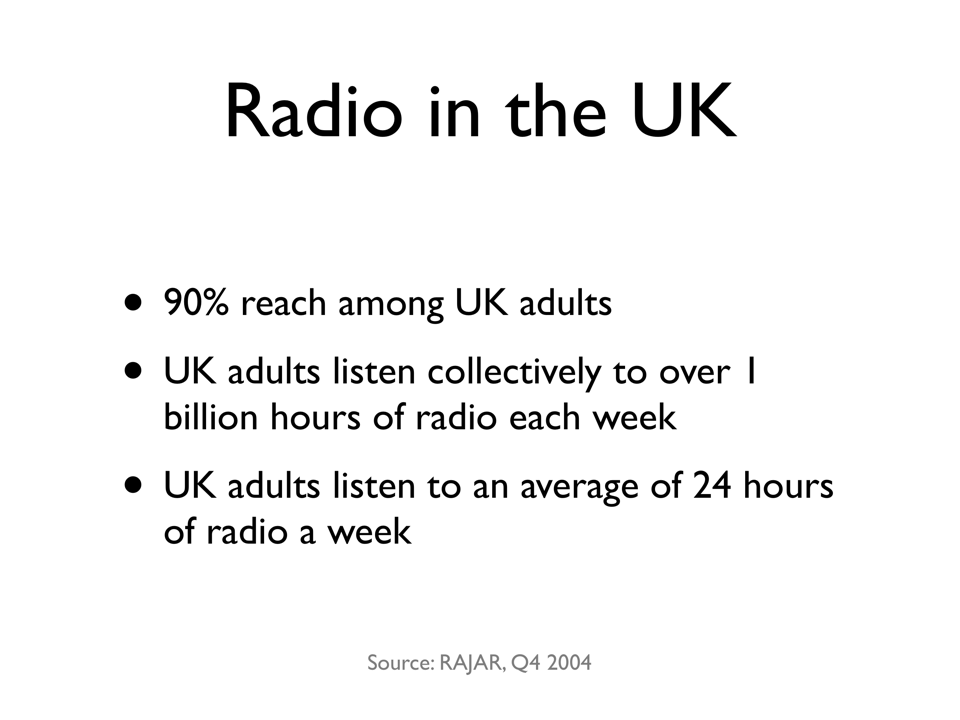
On the screen are some statistics about radio in the UK. In particular, nine out of ten UK adults listen to the radio on a regular basis which adds up to, uh, almost a billion, well, over a billion hours of radio every single week. And, also, the average UK adult listens to radio for an entire day out of every seven, so it’s clear that whilst radio might be an old medium, uh, it’s still an incredibly important one, and the BBC is a significant part of that.
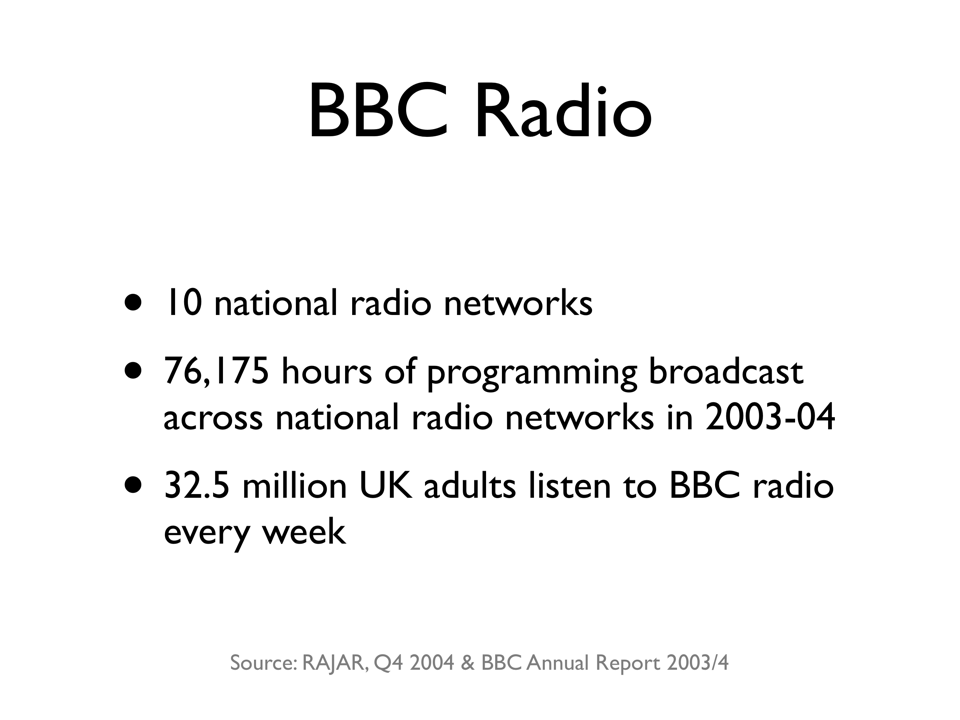
I won’t go into the statistics on the board particularly, but there’s, uh, ten national radio networks that we run, uh, five of them are broadcast on analog frequencies and five of them available through newer distribution technologies such as DAB digital radio. We also broadcast 43 regional radio stations to particular areas of the UK and, uh, and of course, we broadcast the World Service which many of you may listen to. Uh, there are some big numbers on the screen. In particular, that over half of the UK population listen to the BBC every single week.
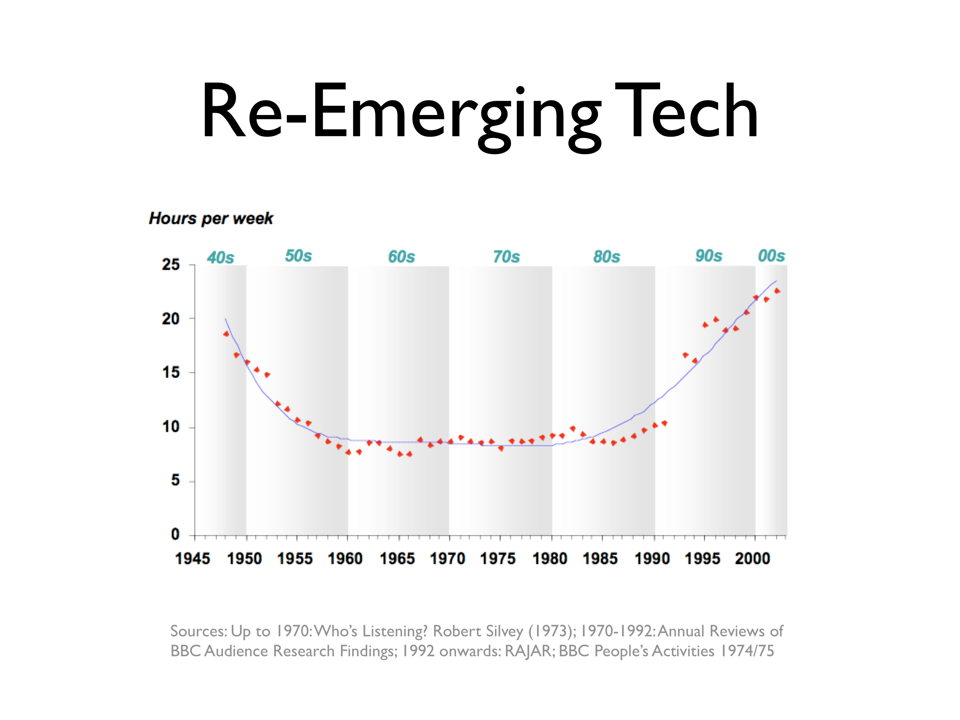
The interesting thing about the audience of radio in the UK isn’t the size. It’s the fact that it’s growing significantly. In the early 80’s, uh, many people assumed that radio was a dying medium. Uh, now we’re starting to see that the opposite is obviously true. In the last decade, uh, we start to see radio’s resurgence. In particular, radio is now more popular than any time, at any time since the Second World War and in the last few years we’re starting to see the audience for radio overtaking TV.
So, as the title of the slides suggest, we think that radio is perhaps a re-emergent technology.
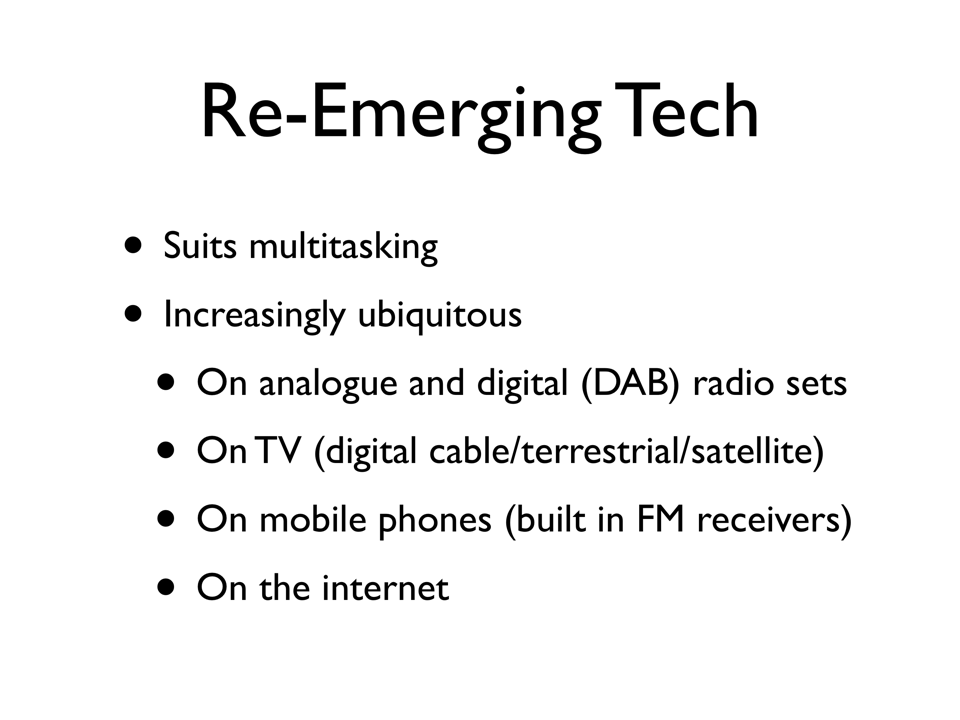
So, why is this happening? Well, firstly, in the UK, we think that obviously deregulation of market has got something to do with it. But there’s also, uh, some more pertinent reasons. Uh, in particular, radio can work in the background. It doesn’t demand your full attention, and you can do other things at the same time. It’s also available in many more places. You can get, uh, radio stations on digital TV systems in the UK. You can get them on mobile phones, both with embedded FM radio chips and also, um, systems like the the Virgin radio system which will pass(?) through 3G technology.
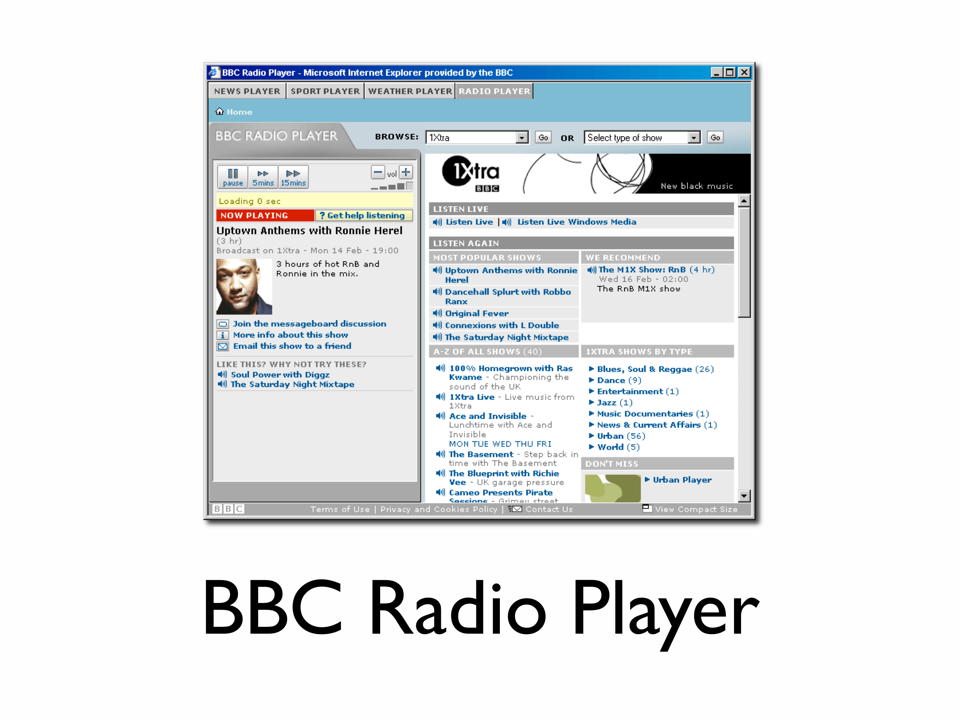
And, of course, you can listen to radio over the internet, which opens up some interesting possibilities such as the BBC’s Radio Player. Um, for those of you who haven’t seen this, it’s on our web site, and you can listen to pretty much any show we broadcast in the last week, at any time, whenever you want. Um, according to our server logs, we’re broadcasting six million hours of radio every single week and four million hours of on-demand radio through the internet.
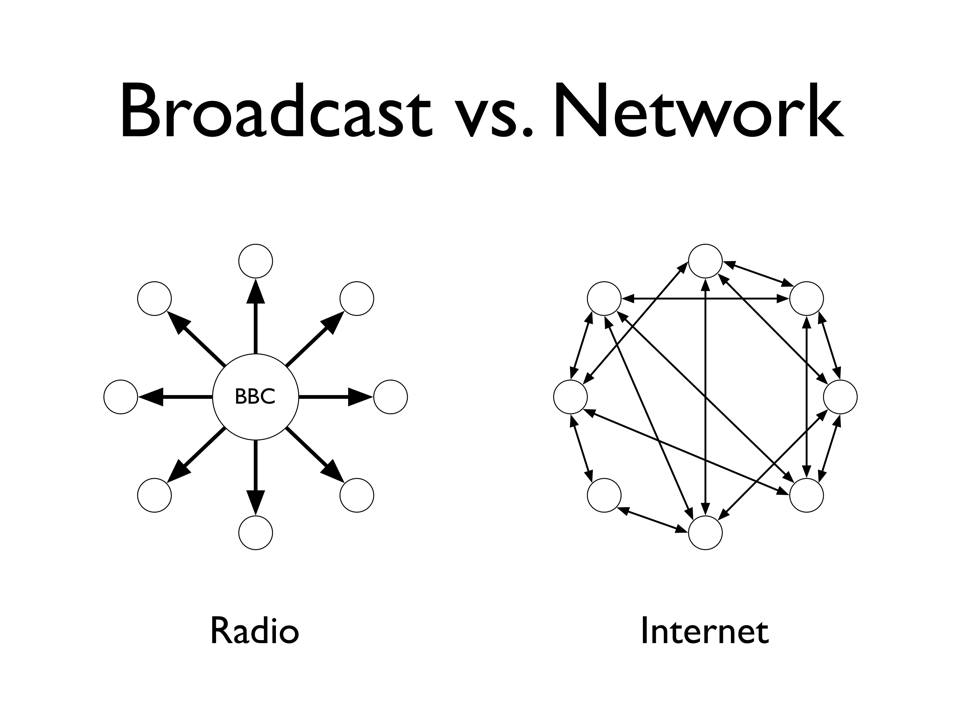
So, radio is a broadcast technology. Um, if we compare it to a social space like the web, then we can start to see there’s some really important differences. On the left, there’s a central node which is broadcasting to all of the audience. But, on the right we see a number of independent nodes which are all interconnected in what you might call a small network, a scale-free(?) network.
So, the question we’ve been asking, and the main subject of this talk, is how we can improve radio by introducing feedback mechanisms and by ultimately making it a more social medium. As soon as you start to consider this question, you start to see that the diagram on the left isn’t entirely accurate. Radio has always had a return path.
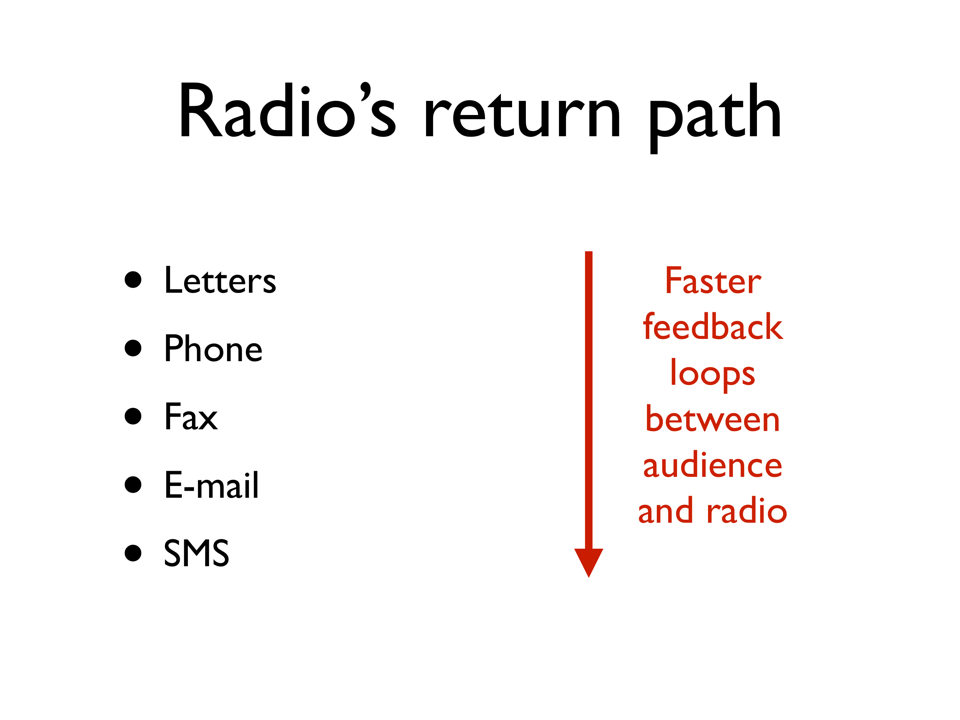
Since the very first broadcast, radio stations have received letters commenting on and complaining about their programs. And then the phone was invented, uh, which led into, uh, led to the talk radio show. And then we've had the fax, but that then got replaced fairly quickly by email. In the last few years we’ve seen the rise of SMS, uh, technology being used to communicate with radio studios.
There’s a trend here towards faster, easier feedback loops between the audience and the broadcaster. We’re now at the point where we regularly receive hundreds if not thousands of text messages within moments of a comment being made on air. It’s hard to see how this feedback mechanism could get much easier for the audience or much faster. We’re now getting over half a million SMS text messages every single month and this is growing all the time.
But still, when we do things with these feedback mechansisms, we quickly find there’s a limit on what’s possible. This limit is one of bandwidth; not bandwidth as in how many megabits we can fit down a cable or over a wi-fi network, but how much information the people in the studio can handle and how much information we can put back out on air.
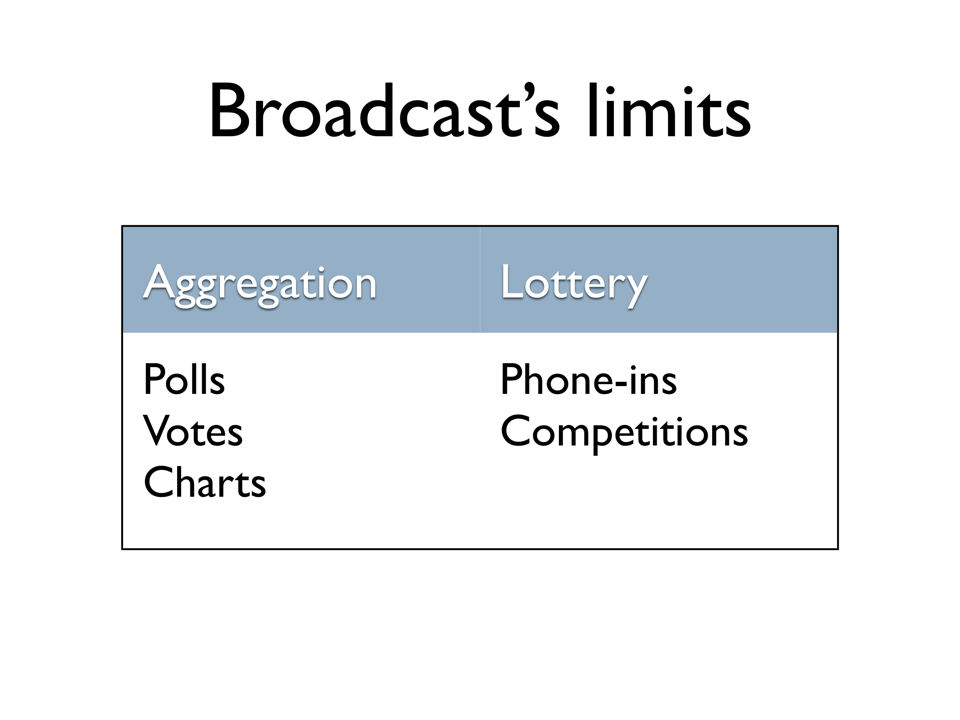
In particular, we find that any radio shows that are based around feedback is based on one of two fundamental models. The first is aggregation, this tends to be limited to questions with a limited range of responses, uh, such as a multiple choice vote or a poll. Uh, the reason for this is that it’s really easy to collate the kind of responses that we get back so it’s easily digestable and broadcastable on air. For more complicated issues, uh, a show will often resort to a lottery approach.
Uh, hundreds of people may phone in with an opinion, or— or text in, but only a handful of those opinions we’ll actually put out on air. And it’s also clear that neither of these models are particularly satisfactory. The aggregation model misses out details and depersonalizes the interaction, but the, uh, lottery model only allows interaction with a tiny part of our audience.
So, our team has been discussing these issues, uh, for a very long time and last April we decided to try an on-air experiment, see if we could combine the models and maybe make the very most of the interactions between the audience and the broadcaster.
This, uh, experiment is what became known as the Ten Hour Takeover.
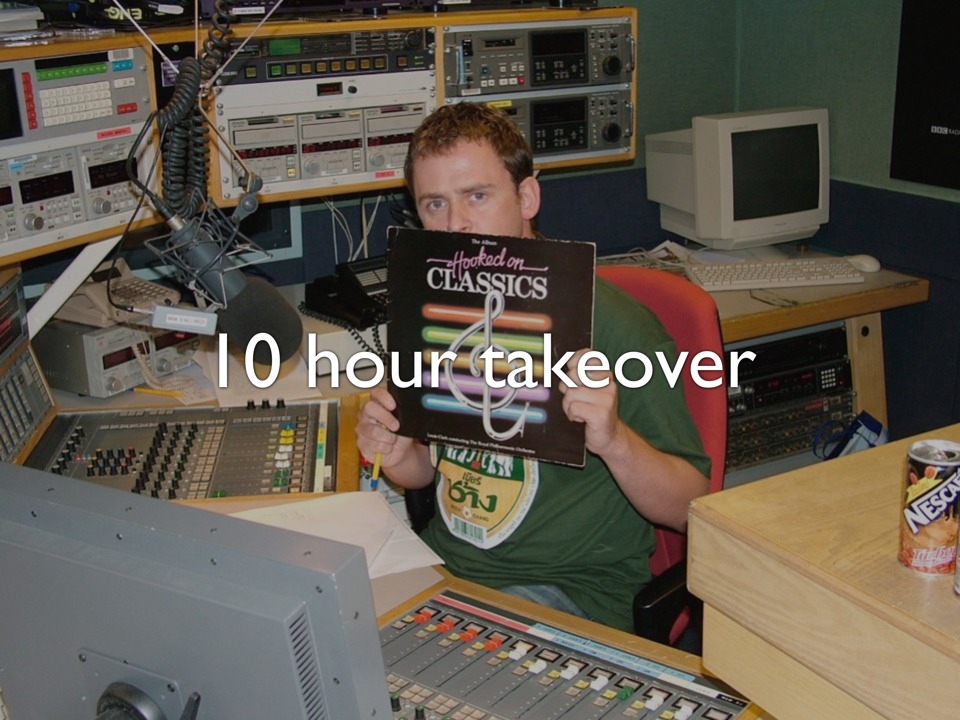
So, the Ten Hour Takeover was broadcast on BBC Radio 1, which is one of our national radio networks. It’s targeted at sixteen to twenty-four year olds and it has a rema(?) to play the best new British music. The daytime programming on the this radio station is heavily playlisted, but for ten hours during a public holiday last April they handed complete control over the choice of records to the audience, who, just by texting in, could pick any song that they wanted to hear. The key thing here was that it wasn’t a multiple choice vote. They could pick absolutely anything that we had a copy of and we’ve got a pretty big record library.
The idea was to push the limits of broadcast interactivity as far as possible. So, the first time we did this, it was definitely a live experiment with a few million people listening in. We didn’t really know what was going to happen, but here’s what it sounded like.
Ten Hour Takeover on Radio 1. Oh! We’re off, we’re running! So, this is how you do it: you can text in from now, for the next ten hours, any track that you want to hear to 81199. We’ve got this new fandangled system set up, so the best way to text in is to put the artist first, then the track you want to hear, then your name, then any other message. That means that if we— if we find a track that’s gonna be played we can search and find everybody who suggested it and you all get a mention. First record, how do we do it, Neil? Should we just go— let’s go to the text, okay. Here we go, okay, I’m gonna take the next one that comes in. Okay, Nelederesgit(?), can you find it for me in your fantastic CD collection that we have over there, in alphabetical order I do believe. We got it? Any time now would be good, Neil. We promise we’ll get much more professional about this as the day goes on. Bear with us, it’s the first record. Okay, and we get, can we get it in there, thank you very much. Lovely, now this is a crapper(?) to start off with and we’re going to play this one, yep? Track 2. Marvelous! This one is coming from Steve Williams in Glasgow. It’s the start of the Takeover, get your text in 81199, the next ten hours are all up to you.
This is Pulp and Disco 2000.
Guitar Man, Brad in Watford and Dominic Vern(?) sitting opposite. Very nice choice. Elvis - Caught in a Trap … Elvis … Mike, Gil and Tom on the way to Engleton(?), big fans of the show … Elvis in the ghetto … Dan … Elvis, All Shook Up, Shaz … Ireland, eh, Elvis, American Trilogy, Steve in Ireland and just to show how well this system works, Elvis Costello.
Nearly 700 people wanted that track in their lives on the Ten Hour Takeover. You just know people up and down the country are going “yes!” Nirvana, Smells Like Teen Spirit. The Ten Hour Takeover. “Radio 1, hello!” “Hello Scott, this is Big Mark from Glasgow. I really think you should be playing Copacabana by Barry Manilow, so get it on!”
I gotta apologize for that soundtrack at the end there, every time we’ve done a talk about this there’s always someone that comes up to me at the end and said, “I’ve got Barry Manilow stuck in my head now for the rest of the day.” Terrible.
Okay, so, um, well, this was a big success. We didn’t know how it was going to turn out, um, and Radio 1 gave ten hours over to it. They came over to the Interactive department, part of Radio/Music, and, uh, we built some software for them to help manage this mess of massive amount of incoming text messages. So, hundred and fifty thousand text messages from a hundred thousand people requesting over six thousand different tracks. We played a hundred and thirty-one tunes in ten hours with three different DJs.
So, let’s see what we did in terms of software.
Step one is about trying to break the feedback loop. If we’re giving the DJs direct access to their audience and, um, giving them the other side of the conversation that they don’t normally hear when they’re sitting in a darkened studio in the the basement of West One, London, with no windows, then what we don’t want to do is just give the listener just a one-to-one experience where what they say goes straight to the DJ, DJ does what they’re told and there’s no mixup coming from the community. Otherwise, we’re just ending up in the old models again. So, step one is about let’s allow all the listeners who’re normally listening separately, um, having their own experience, to see what everyone is texting in. So, step one was putting up a live thing on the BBC web site during the program so you could see the flood of text that was coming in.
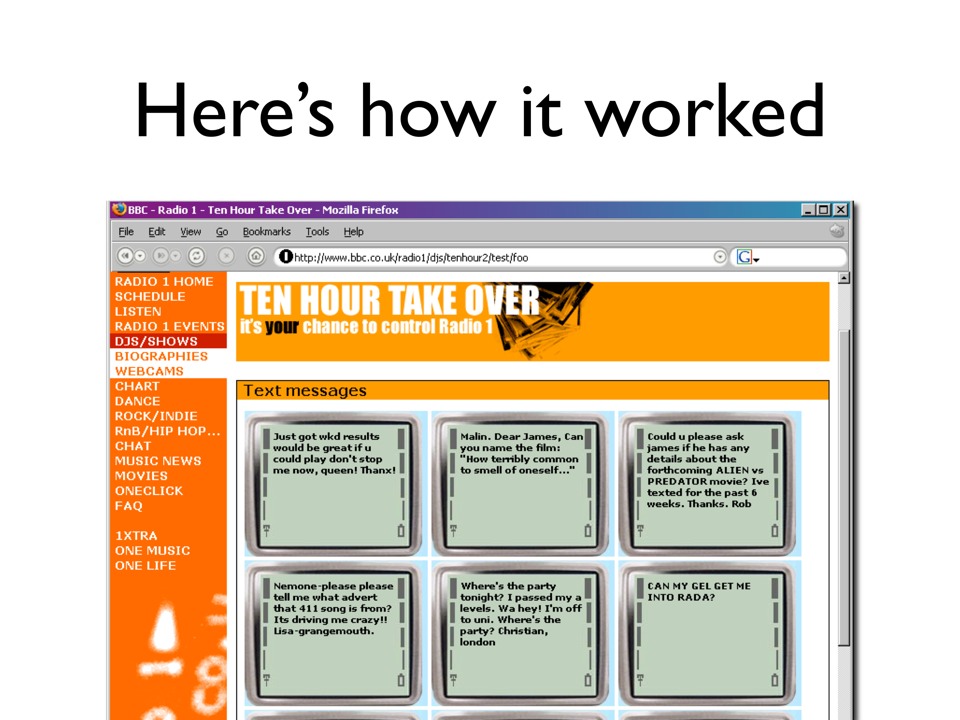
So, obviously we had to, um, step one in doing this sort of thing is controlling the content just a little bit. BBC’s, uh, got a massive audience: we had over a million listeners for this program, so there’s a certain amount of profanity filtering and moderation that goes into this, but actually compared to the way the BBC normally runs this kind of experience, this was absolutely live. It’s just a simple text filter for a controlled list of swear words and every thirty seconds, ten of the latest text messages went up on the BBC web site.
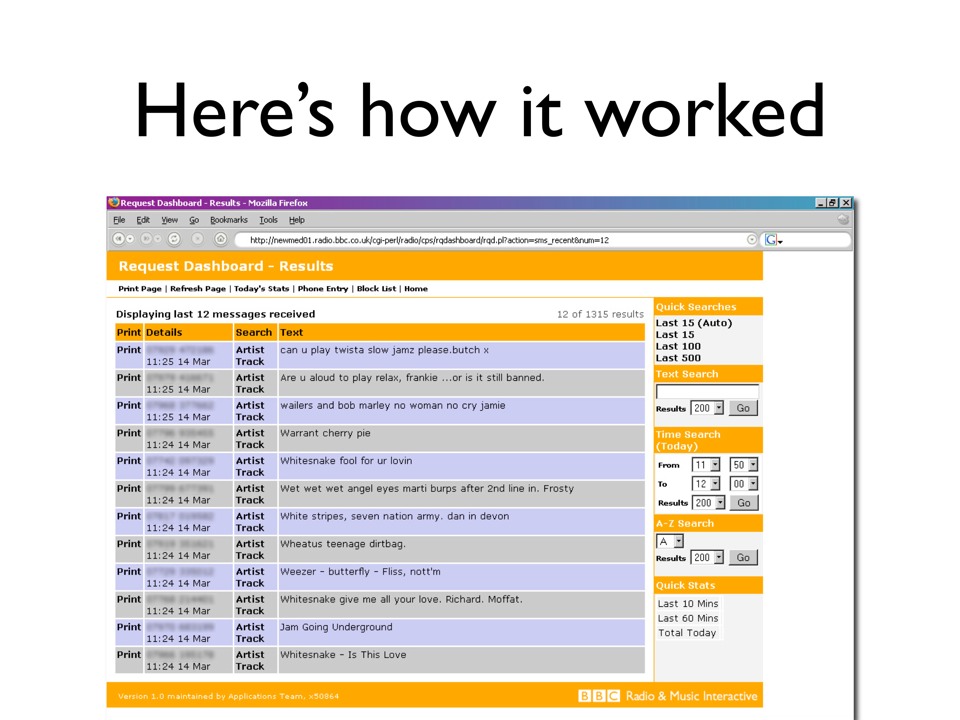
In the studio, well, we gave them an inbox. It’s just a chronologically ordered— reverse-chronologically ordered list of text messages, but the interesting thing you’ll see (if you’re sitting anywhere close to the screen) is there’s an extra button along with the ID for the listener and a bunch of stuff for search: Artist and Track.
Now, as Paul said, we didn’t want to restrict people to some sort of simple vote system — text A for “Kylie,” B for “Madonna” — and, instead, to completely open up the field and show people that they could get anything they wanted played. So, all we asked was that every listener text in the artist followed by the track followed by their dedication. And then, we took advantage of the fact that we have over a million listeners. This gives you a massive text corpus for analysis, and if you apply a bit of tokenization, a few transformations to, sort of, get rid of the fuzz of spelling mistakes and different phrasing, um, for example, “White Stripes” versus “The White Stripes,” then actually you can do a pretty good job of finding the patterns in the incoming text.
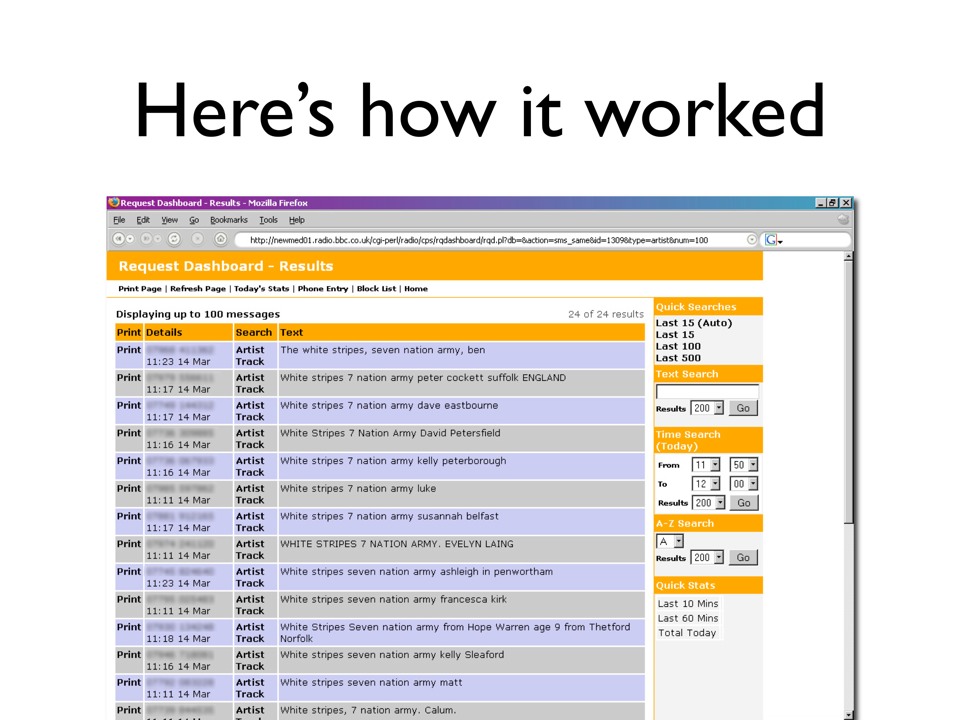
So, if you were to click on Artist next to, uh, an incoming text that said “White Stripes Seven Nation Army” — because you’re gonna play this tune, but what you don’t want to do is just say, “I’m playing it for Bob in Leeds,” you want to be able to open up to the rest of the community who asked for the same thing. And what we do is, we try to find the inflection point in the text message. If you compare one text message to another, there’s a probability that the tokens at the start of the message are going to allow you to predict those that follow. So, “White Stripes,” “The White Stripes,” “White Stripes Seven Nation Army,” “White Stripes Button to Button,” those are two separate and entirely distinct probabilities. So, we cluster things together by their prefix, tokenize them with the metaphone, a sort of soundex-like algorithm, to, ah, move to a more phonetic set of tokens than a simple text comparison, and then bring them all up together on a screen for the DJs. Now, if you can see that, you’ll see there’s a lot of variation there: there’s “White Stripes,” “The White Stripes,” “Seven Nation Army,” the number seven, the word “seven.” We used a dictionary of common texting transforms, number 4 versus the word four, things like that, in order to cluster things together a little more. Now, hundred and fifty thousand text messages, it doesn’t sound like a lot if you’re used to provisioning servers for web serving; millions of requests a day really not a problem these days. But actually, this is absolutely about liveness. This was about directly connecting the feedback loop from the listeners back to the DJ so that people would be inspired by what they were listening to, text back in and the DJ could immediately shape their program-making based on what they were seeing.
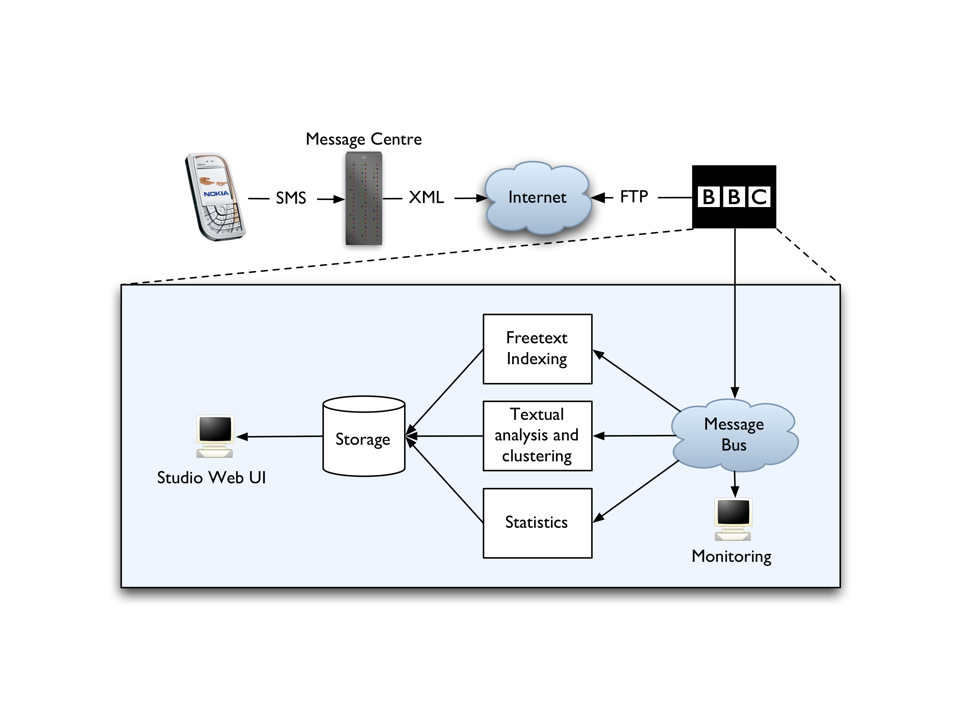
So, what we set up was, in the UK, at least, at the moment, you can buy SMS services. You can get a shortcode, uh, and a feed from a third party and plug it into whatever systems you want to at your end. So, we set up a system using our provider’s favorite protocol, XML-over-FTP (in variation to the current, uh, favorite) and then reflected them over a message bus so we could share this infrastructure with multiple applications.
Uh, you can see in that diagram we have free-text indexing for the search box on the DJ’s console. We have the textual analysis and clustering that does the, uh, the matching, the clustering between the various texts and we have a statistics application. And then it’s just a case of sticking it into a database and putting a web interface in front of it.
So, this all worked extremely well. The tool was just given over to the DJs; all we needed was one of our guys in the studio, just to keep the database ticking over, make sure nothing went wrong and they did the rest. So, it was a great big success. They’ve repeated the event twice since then. We’ve had two more, uh, public holidays. We’ve had ten more hours each day of this program, um, and we’ve heard from Radio 1 that people have said they can’t imagine what they would do on a bank holiday now except for another Ten Hour Takeover.
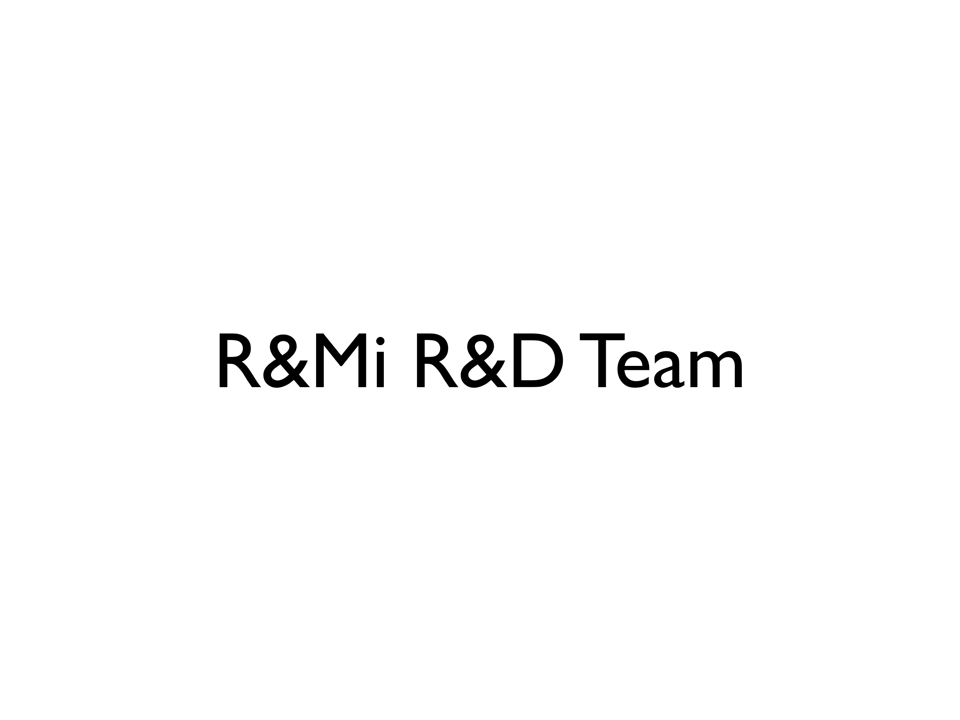
Now, I’d like to hand it over to the Radio and Music Interactive R&D team.
Hello. Ooh. Hello!
Hello, I’m Tom Coates and this is Matt Webb and we are the Radio and Music Interactive R&D team. Um, say hi, Matt.
“Hello.”
Um, uh, Matt’s gonna come up at the end to help us answer some questions, if you have any, assuming that I haven’t written an enourmous number too many slides, which I probably have.
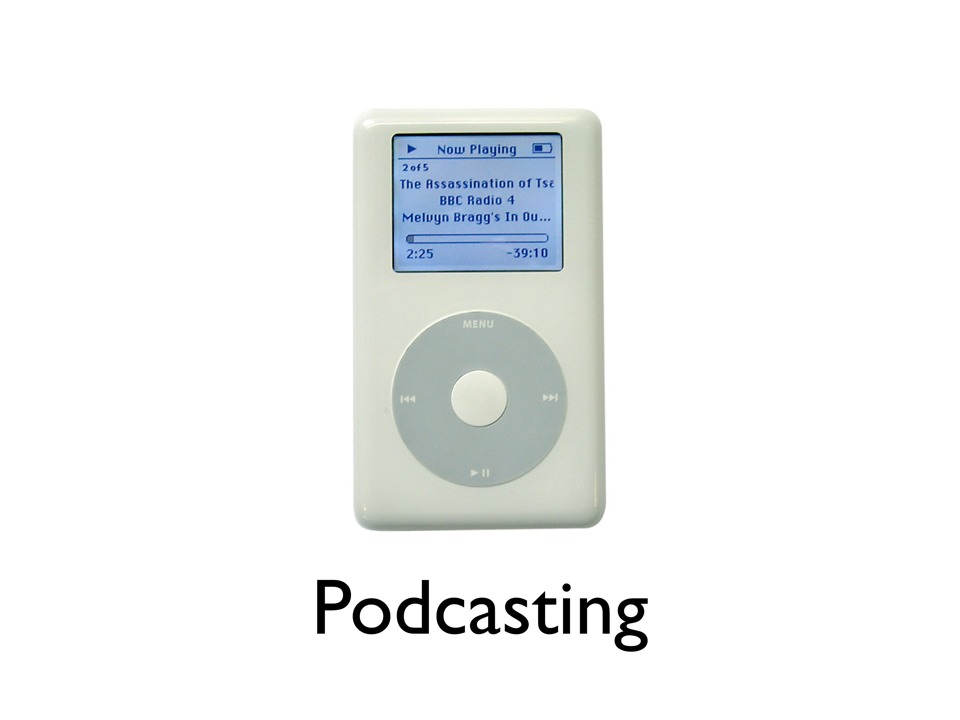
Okay, um, this is the kind of thing we do, actually. Just briefly, to kind of get you in the mood a bit, our team worked on, um, pod— getting the BBC doing its first podcasting trials, making us one of the first broadcasters in the world to actually play with podcasting. That was very cool on that one.
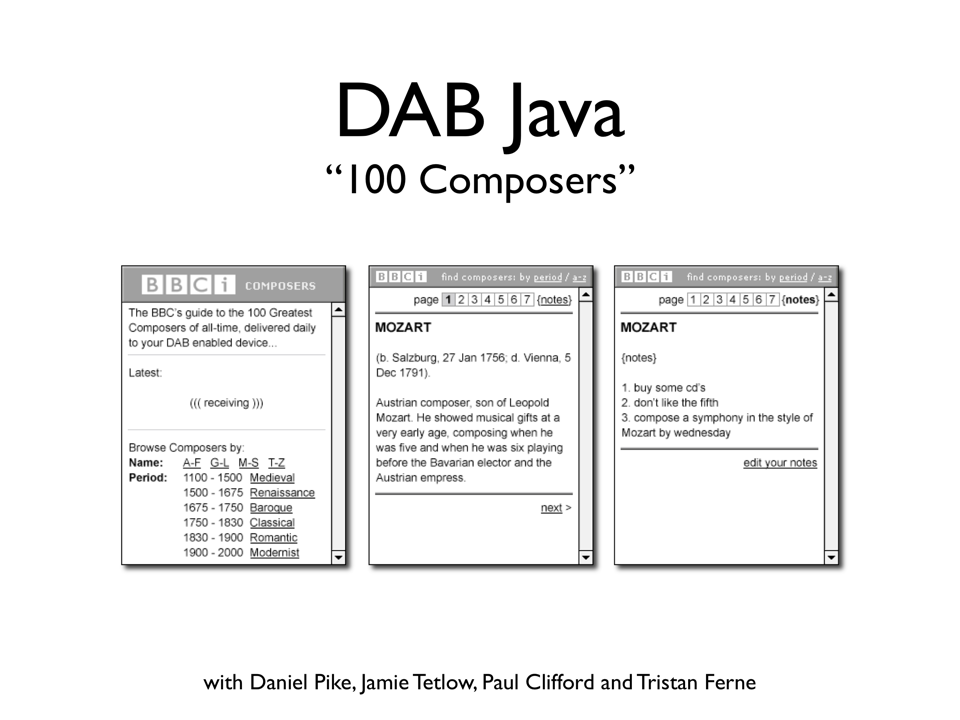
Uh, we did a project called DAB Java which is about broadcasting small applications and data across the, um, radio frequencies, across the actual transmissions that the— the— the radio networks themselves go out. That was quite fun.
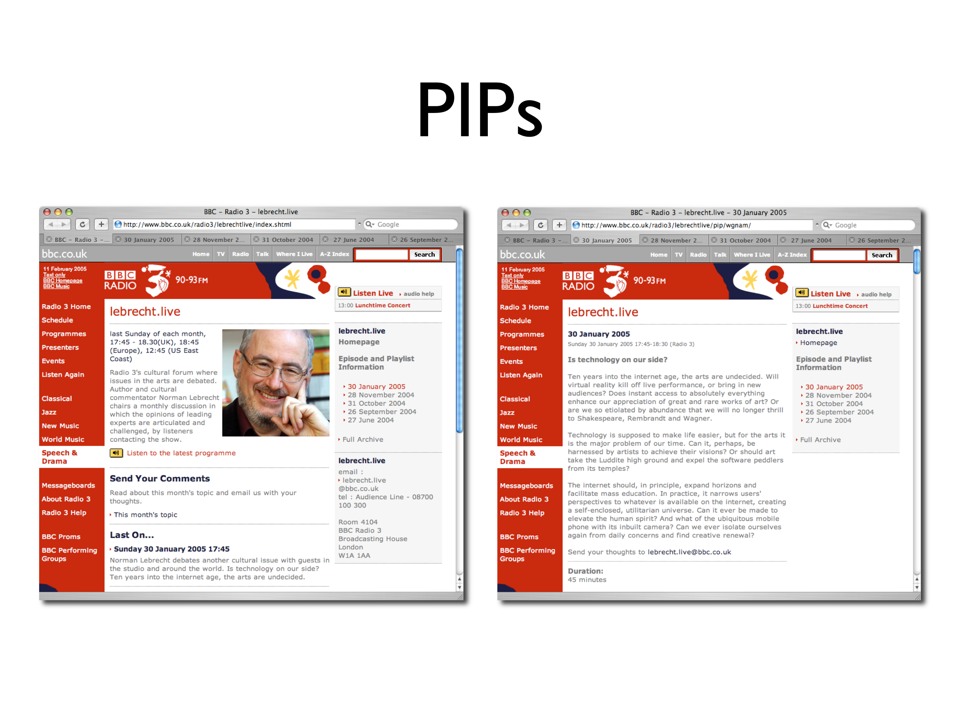
Um, we're in the beginning of a project called PIPs, which is Programme Information Pages, which we're doing actually another paper on later in the week, uh, it's about programme information, but we're not really going to talk about those.
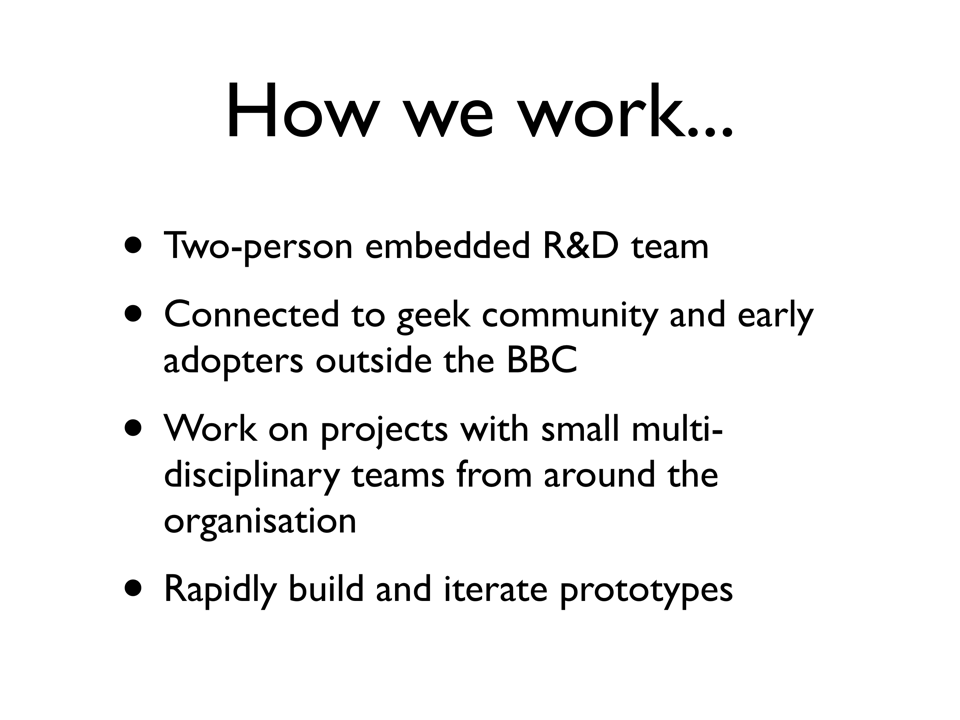
It’s an emerging technology conference, so it makes sense for us to explain a little bit about how we work. There’s an awful lot of R&D teams in the BBC. Some are very large, some are very, very small and we’re possibly one of the smallest: there’s two of us. Uh, we co-manage each other. Um, uh. Um, I’ll tell you, um, my job’s the hardest. But, um, uh, we’re really embedded in the heart of a production department, um, so we’re in the middle of the people who actually make the web sites and do the distribution networks and, you know, think up what to do with interactive radio and stuff.
We think it’s really important that we’re connected to this kind of larger geek community outside, and early adopters, otherwise we’re not going to be very useful in terms of bringing that kind of stuff in. We’re a very kind of short term— we’re very kind of— we’re not like five, ten years ahead, we’re more, kind of, rapid prototyping team, we do things, kind of, eighteen months ahead, things that are plausible now.
The way we work: we assemble small project teams from around the rest of the department. We’ll get a designer or producer from the radio station, or a coder, developers, whatever. They come and work with us for, like, uh, a couple of weeks to try and flesh out and develop a concept, you know, to a certain level of complexity and we rapidly build them and when we’ve built them, if they’re not very good, we throw them away and we build something else. Oh, we iterate a lot.
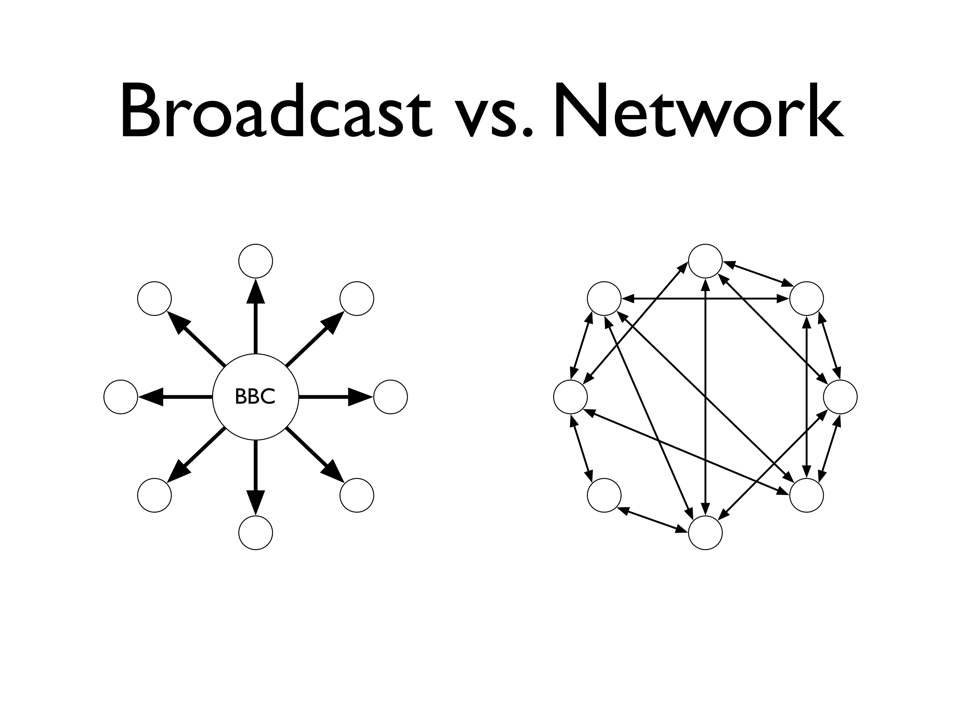
What we’re going to talk about, basically, is this diagram that Paul put up a minute ago about broadcast versus network. I think what we’re trying to do in this thing is find ways to hybridize these two spaces. You know, you’ve got a, kind of, web presence, you’ve got a broadcast network, you’re trying to find ways of making interactivity between the two. Uh, so just trying to find a way which these kind of two ways of interacting, these two ways of connecting, can actually co-exist in a useful way.
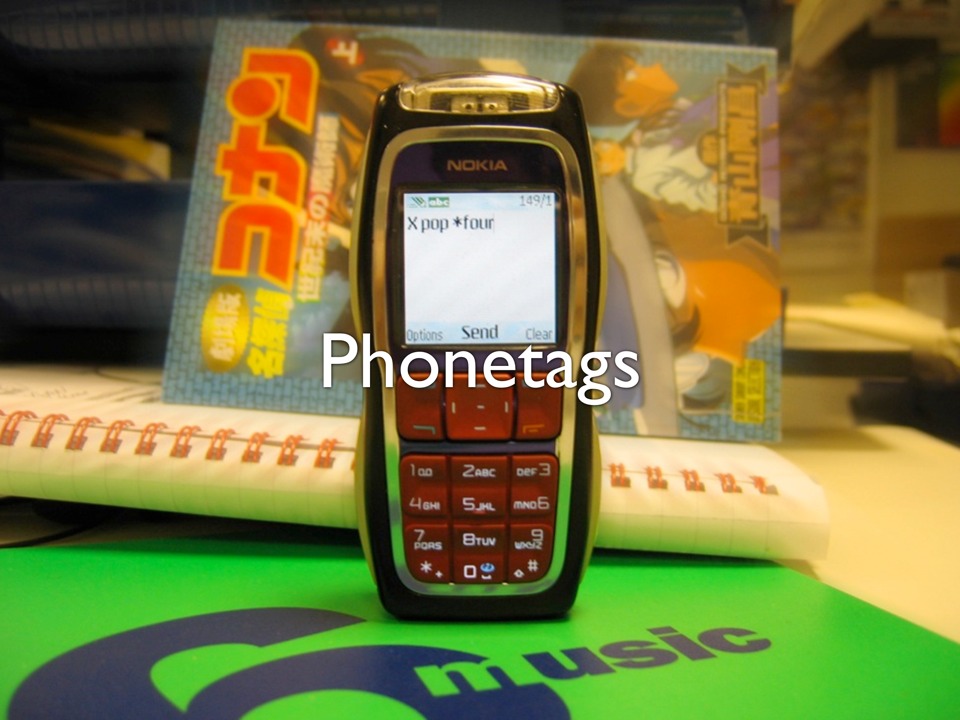
The first project we did around this kind of area is called PhoneTags, and here is a picture of PhoneTags. This is— this is, um, Matt’s famous phone which he uses for an awful lot of things including, um, if you were there in Matt— Matt Jones’ talk earlier, to write rude words in lights.
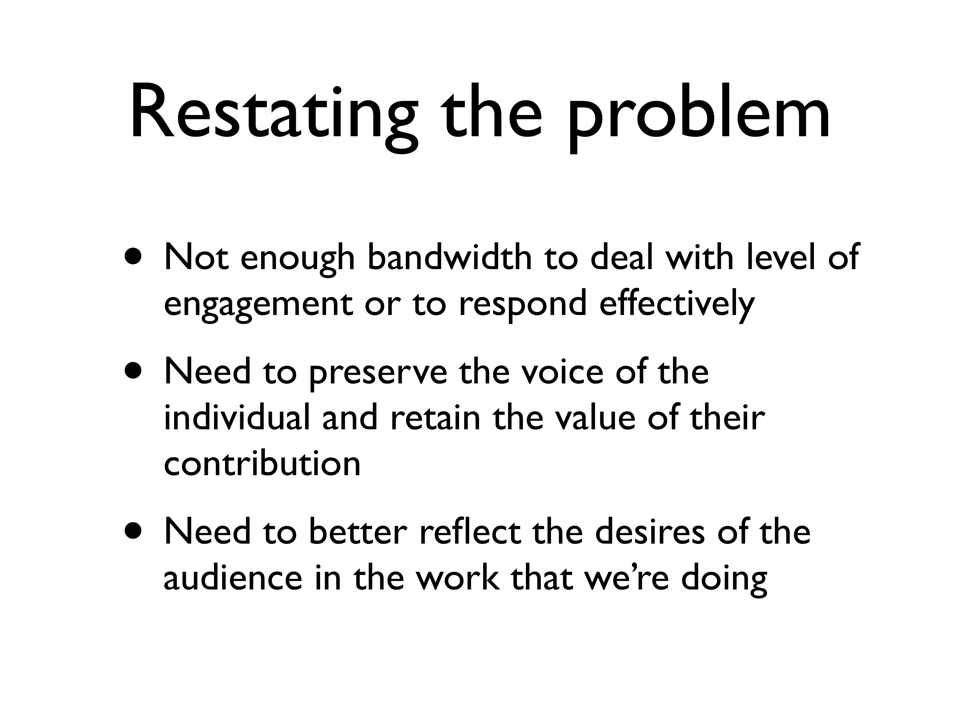
Now, I think the problem that Paul talked about earlier, to restate it, we have problems with bandwidth: we don’t have enough bandwidth to deal with the level of engagement that we should be expected to-- to do. There's, like, millions of people out there and there's kinda institutionally one of us. It's very hard to deal with that kind of, you know, how to make people feel they're contributing usefully and how to respond to them effectively. It's really important I think for us to try and preserve that voice of the individual. That that problem that Paul talked about of aggregation or polling, you know, um, that we get kind of random people, you know, we set them up as representatives of everyone else or we just, kind of, smoosh it all out to some kinda gray level, I mean, that's not good enough, we want to find ways of preserving that that voice of the individual and, you know, broadcast-- we want to, kind of, better reflect what people want, you know, what reactions they're doing what how they feel about what we're broadcasting.
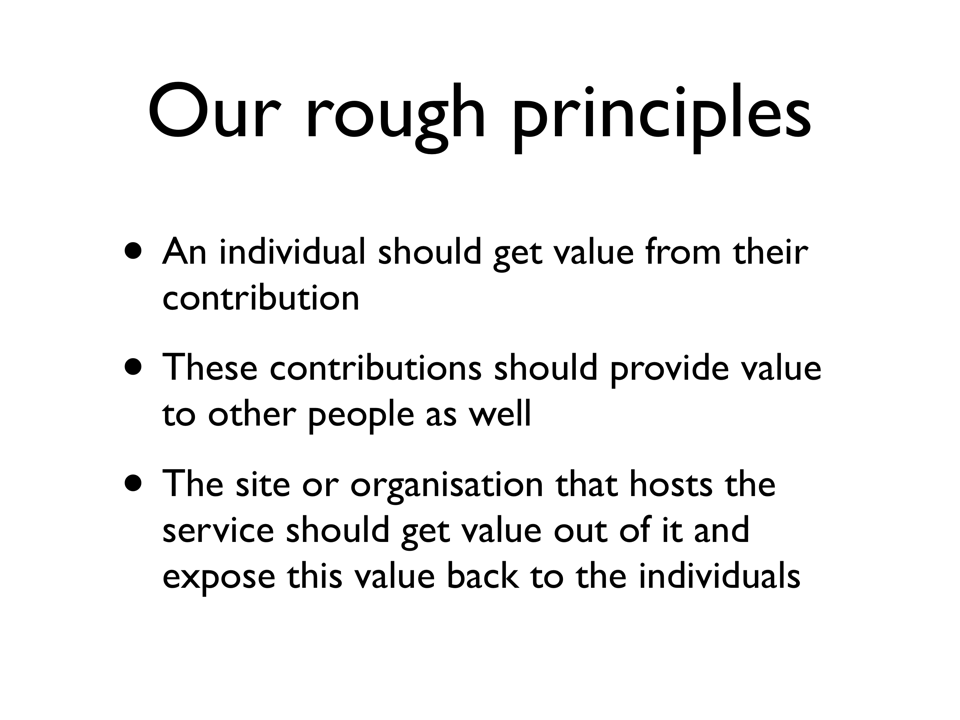
So, I mean, as part of this we've, kind of, working around some principles of social software to try and find a way of kinda merging the two effectively and these are our rough principles that firstly an individual should get value from their contribution.
So that's obviously very different from a kind of you know uh a lottery style engagement with the radio. We don't want it to be that ten thousand people call in and only one of them gets picked. that's not good enough. On top of that we want to make sure that those contributrions provide value to everyone else that all their peers get something from that. and finally and most importantly for us well it's kinda two fold this one that we get value out of it and that we can reflect that value back to teh user at teh beginning so there's this kinda nice satisfying social software loop of engagement where individuals get value the comunity gets value the science service gets value and can put that back to users.
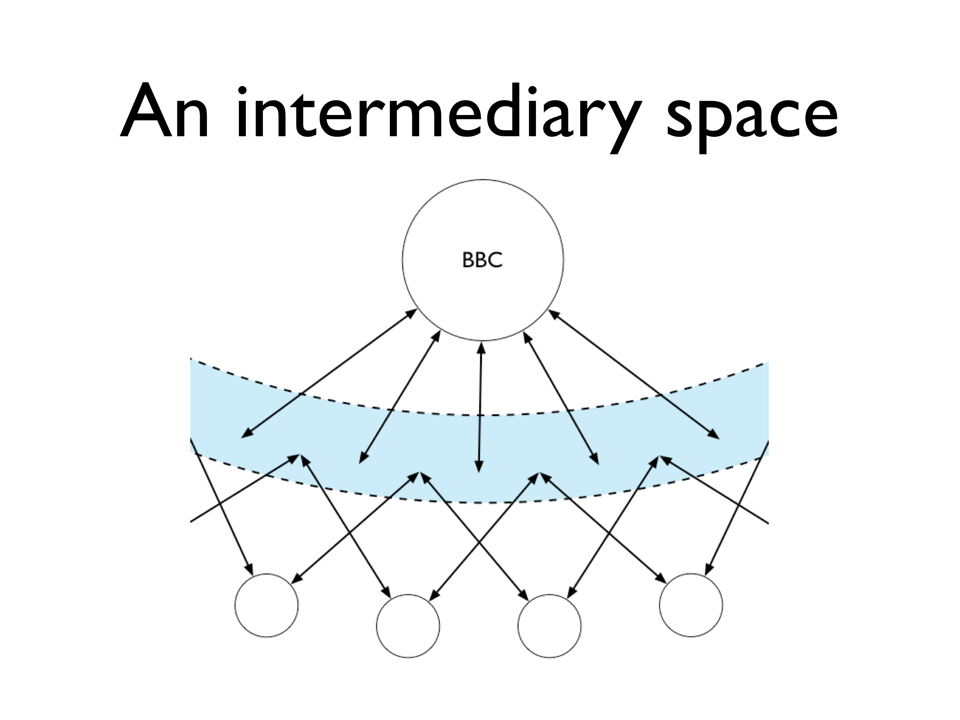
The thing in this particular one it's kind of about thinking about the BBC as kind of a peer trying to get it to be more like a peer in a peer-like space rather than a large kind of a overarching kind of Sauron's eye in the sky and I think the way we've kind of is that oh okay um I'm going to get shot when I get back to work um and I think the way we thought about this one was this was kind of an intermediary space we need to find a way of kind of putting large amounts of cotton wool and padding all around the BBC so that it can play nicely with the other kids.
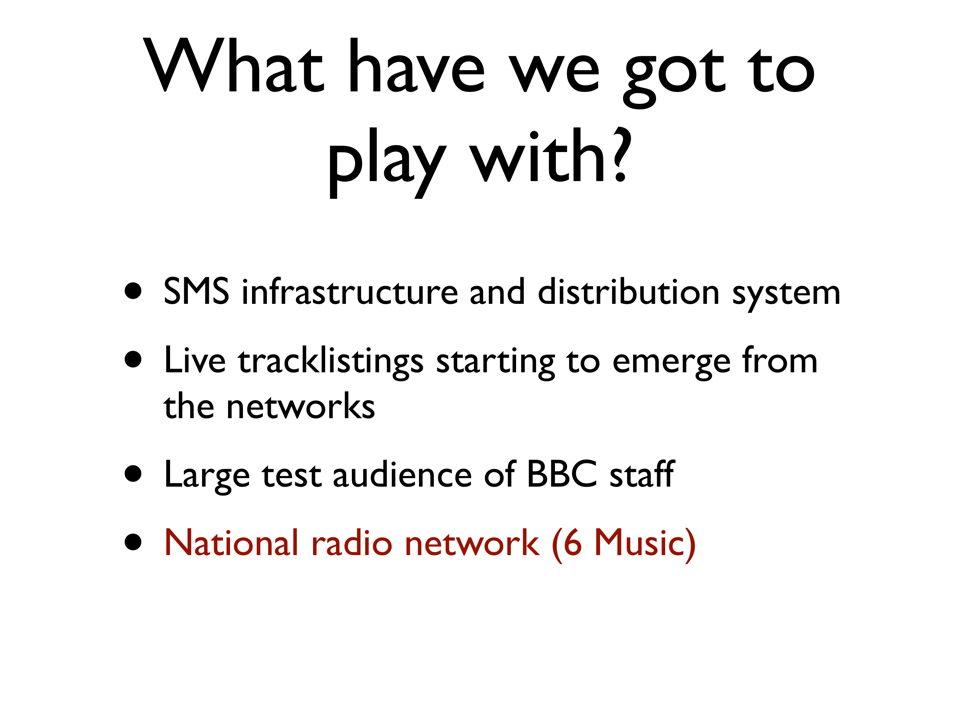
So we got this principles of socal software and we have this kind of concept of a an intermediary space and what else have we got if we want to build things we have this we have an SSS infrastructure and distribution system courtesy of Mr. Biddulph and his team we have live track listings that come from the radio networks so this is like the actual playout systems the ones that put the songs on the air have you know metadata around them we know what songs are playing for the most part when they come out and that's kind of this is newly emerging data for for some of the networks who are in
We also have a large test audience of BBC staff with whom we can play and see what they do uh and course we also have a toy a rare toy a rare pleasure our own national radio networks always fun so um from this stuff i mean it's I think it's important this is kind of how we work you know we try and encourage people to build in infrastructures put them in place we show them how they can fuse them together in useful and interesting ways to do things that are kind of on the edge and cutting edge in, in various ways
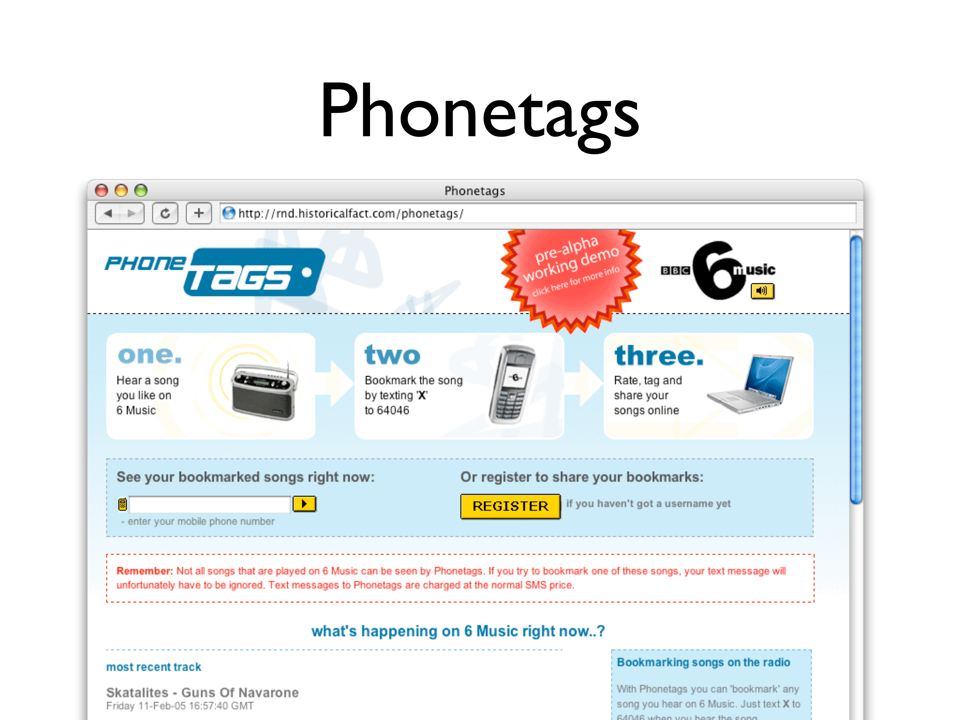
this is the project we came up with from this from this group around that concept of trying to build that intermediary space and its called phonetags here's the site the core concept is you can kind of see the 1-2-3 at the top there that um if you hear a song on the radio you like you should be able to type an X on your phone text it in and it bookmarks it come back to the web later and then you can type in your phone number see a list of those bookmarked songs
now I mean we're not immune to fashions so obviously we've put in some small folksonomy related tagging mechanisms so if you want to put any other words after that any other any words at all after that X you can type in you know that this is a song about summer or trees or badgers or merangues or potatoes whatever you want and then you can go back later and look at all your potato songs or all your meraugne songs or all the songs to do with being happy and having fun 00:22:58-2
uh we also added in this other concept called magic tags which I think are particular appropriate for kind of SMS interactions on the web you might just use different interface widgets but this is about special magic powerful words that do different things in this case if you type in *5 or *3 you can rate the song that you are hearing on the radio at that very moment as a three star song or a five star song and again you can kind of browse that on uh on your own kind of service 00:23:22-1
so like let me just give you a quick run-through some of the pages involved in this and then uh after the talk we'll put up the URLs so you can have a play not actually unfortunately with the sending in bookmarking songs but you can kind of browse through the space and see if we've come up with any interesting new usability widgets or concepts that you might like to play with um you might see a few from flickr as well but you know 00:23:41-5
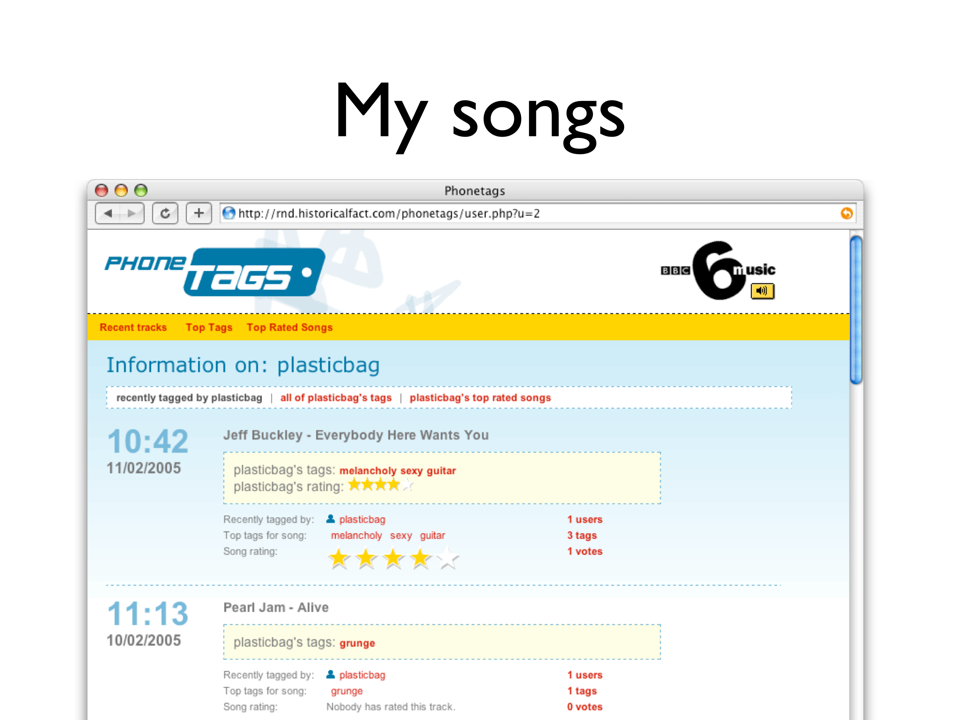
um so this is my songs I've heard a song on the radio I've texted an X in and um come to the site typed in my number here are my songs the songs are recorded you can see I've booked a Pearl Jam song there that I've imaginatively tagged grunge and uh a Jeff Buckley song I've given four stars I can explore those in slightly more detail
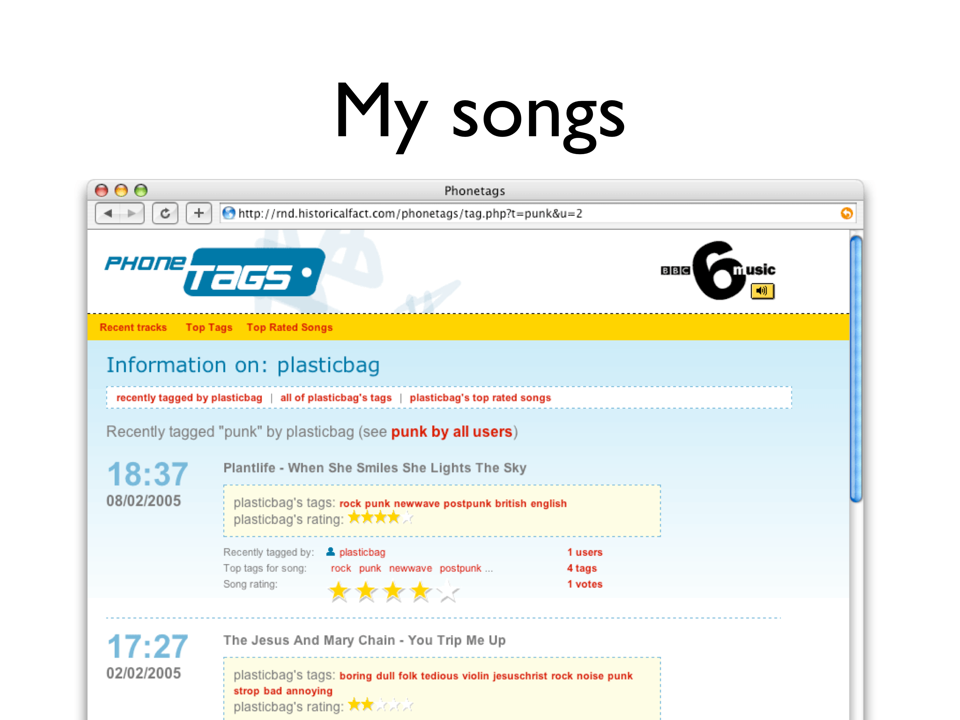
here are all my punk songs all the songs I've heard that I think have to do with punk that I like in whatever reason 00:24:06-2
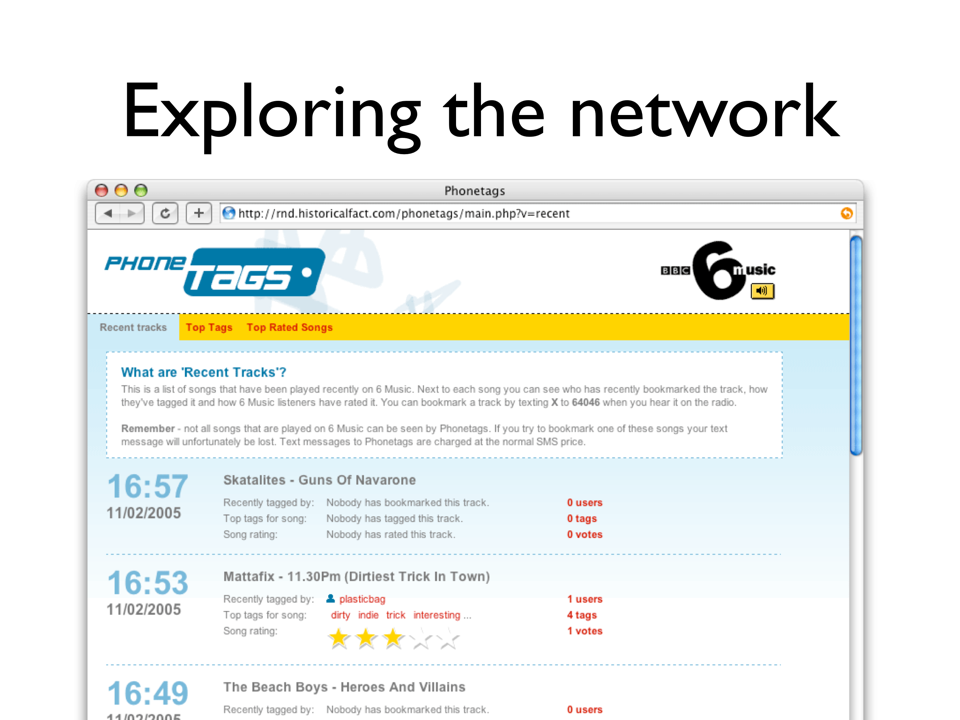
so the rest of the network getting value from everyone else you can go and look aronud what other people are doing so there's tracks that people have been bookmarking across the um the radio station see what they're saying about it seeing how they're describing it seeing how they're rating it
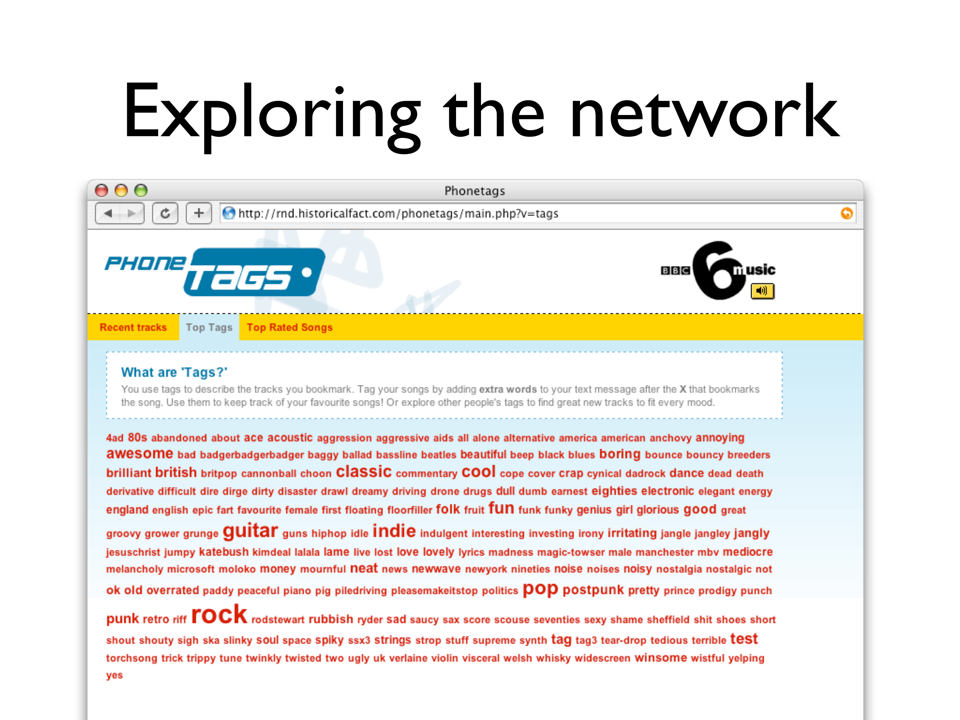
heh imitation sincerest form of flattery mr butterfield terribly sorry um we've we've heh heh my idea again sorry matt um this is the top tags on the entire network so you can kind of find the bigger tags obviously reflect on more popular tags you can go and explore more like the songs on the network that are most rock or indie or pop or guitar or cool or jangly or you know manchester or whatever you can go explore them we'll show you those in a minute 00:24:43-8
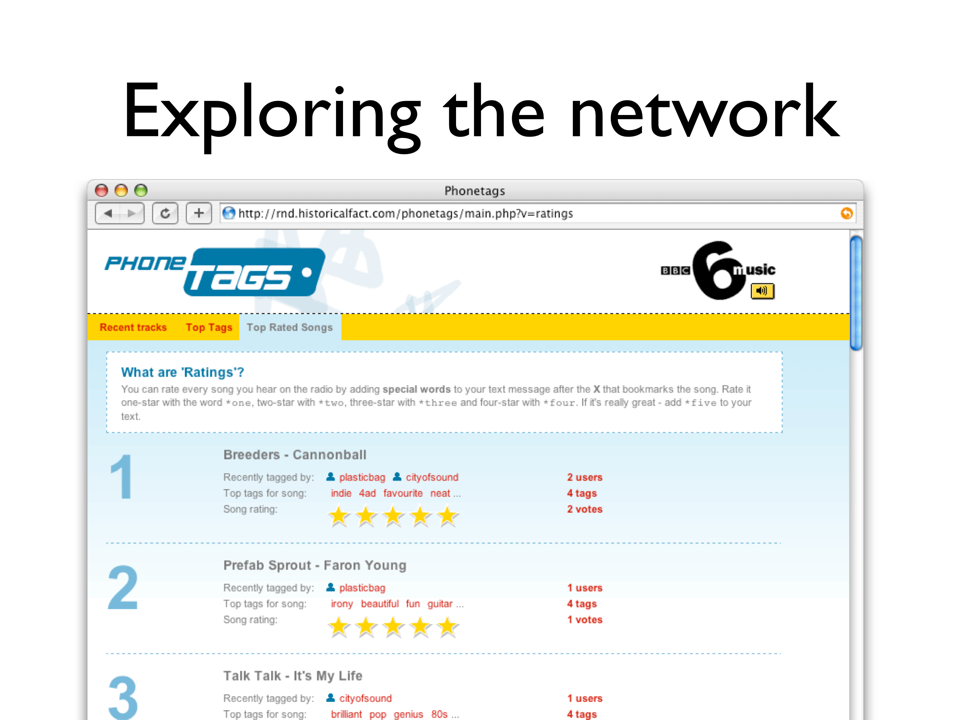
and here's the top rated this is the aggregation of all the top rated songs on the network so you can see which are the most popular songs 00:24:48-3
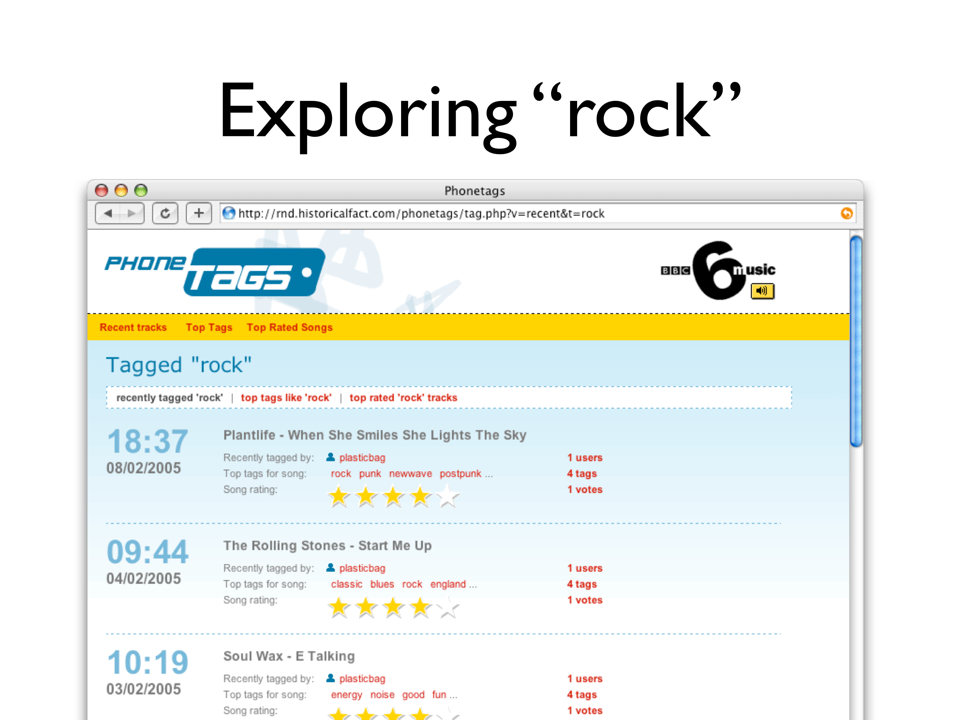
if you go and explore a concept explore a tag this is the most recently tagged songs um under the tag rock
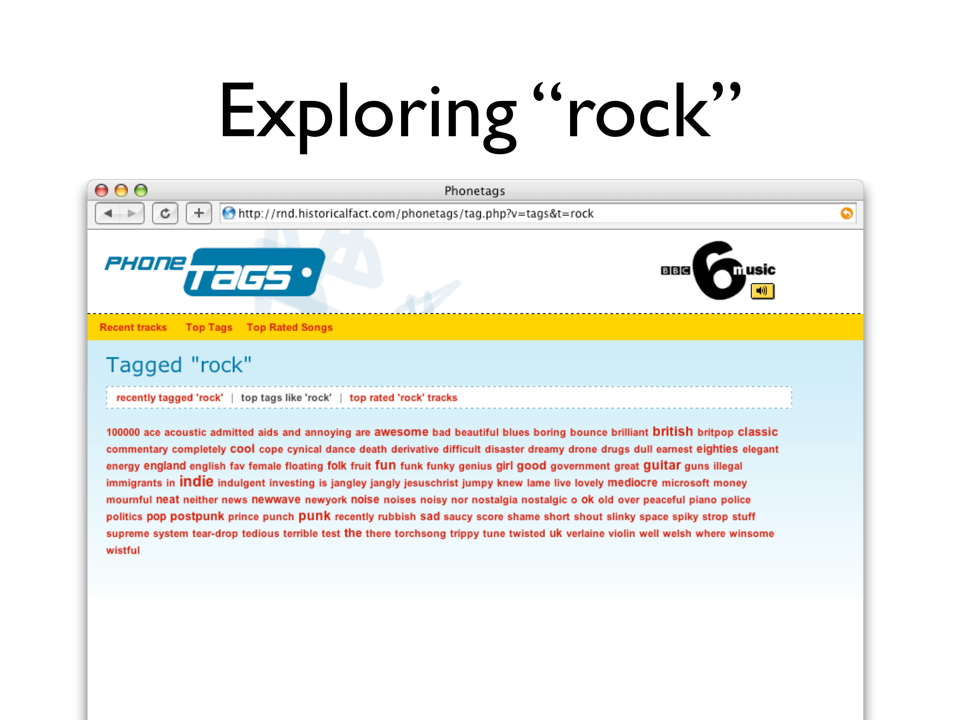
this is the most interesting one this is all the related tags I think I mean everyone knows this stuff but it's it's it's really useful because it gives you that kind of semantic meaning you start looking at it and thinking ooh that's interesting you know if I look at rock I can see all these other related words I can see kind of what rock means in term of kind of relationship to other tags 00:25:13-7
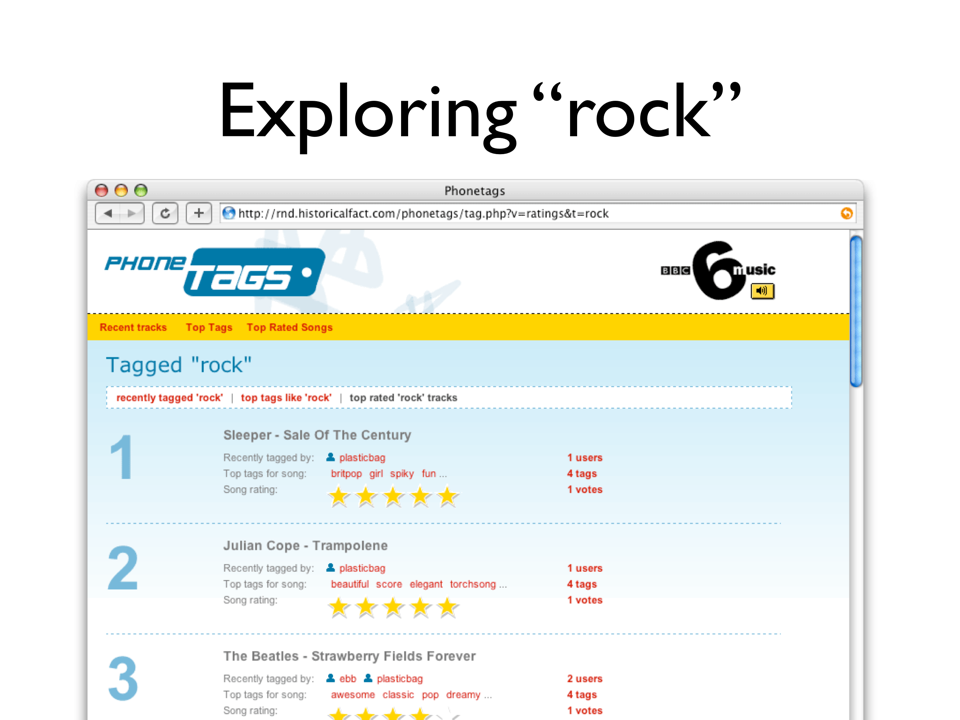
I will I think I will talk more about that in a second actually this is my absolute part page of the entire site really for any given tag you can see the top rated songs for it so you can go and look for your favorite songs to do with some everyone's favorite songs to do with summer everyone's favorite rock songs everyone's favorite indie songs whatever it's really nice 00:25:32-8
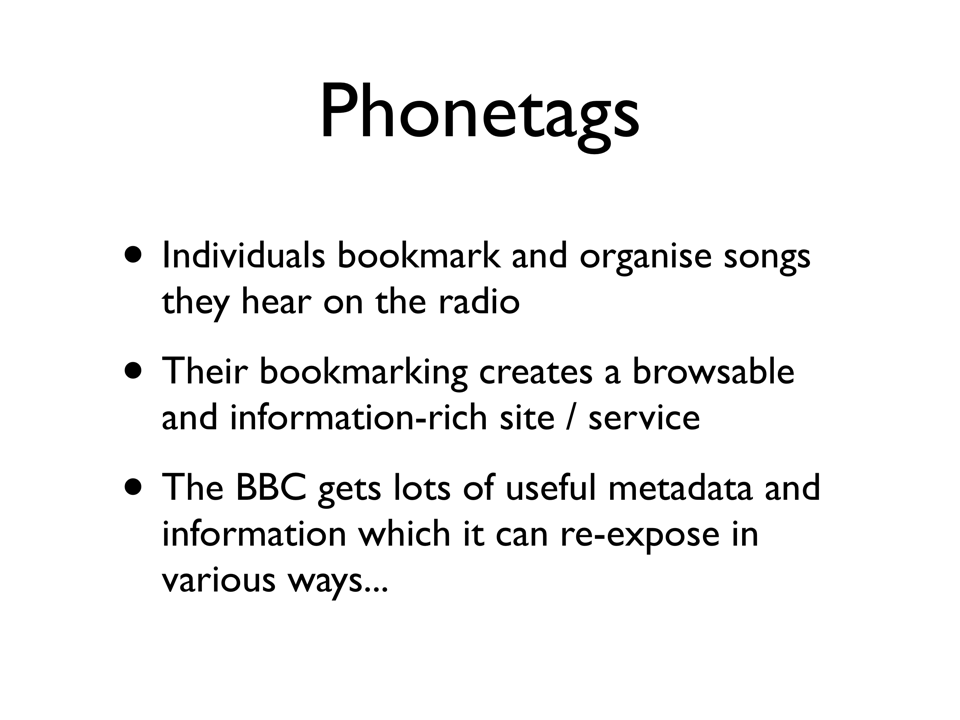
so my against those three principles we had earlier this basically how phonetags stacks up. firstly the individual bookmarks and organizes the songs they hear on the radio they get the immediate value out of doing something whatever they do they get value out of everyone else gets value from that too because they get this kind of rich browseable experience which gives them more meaning i think particularly useful in terms of that kind of concept of music discovery I like this I want to find other things I want find really good sh-- good songs that I'm going to respond to um we get a lot out of it as well and we can expose that to people what we get out of it immediately is a lot of useful metadata about song how to describe songs what a song is what it means what it's like and it's kind of gives us this amazing virtuous circle a really positive way of getting data and information that we can use in a whole range of different ways so here are some of them 00:26:20-3
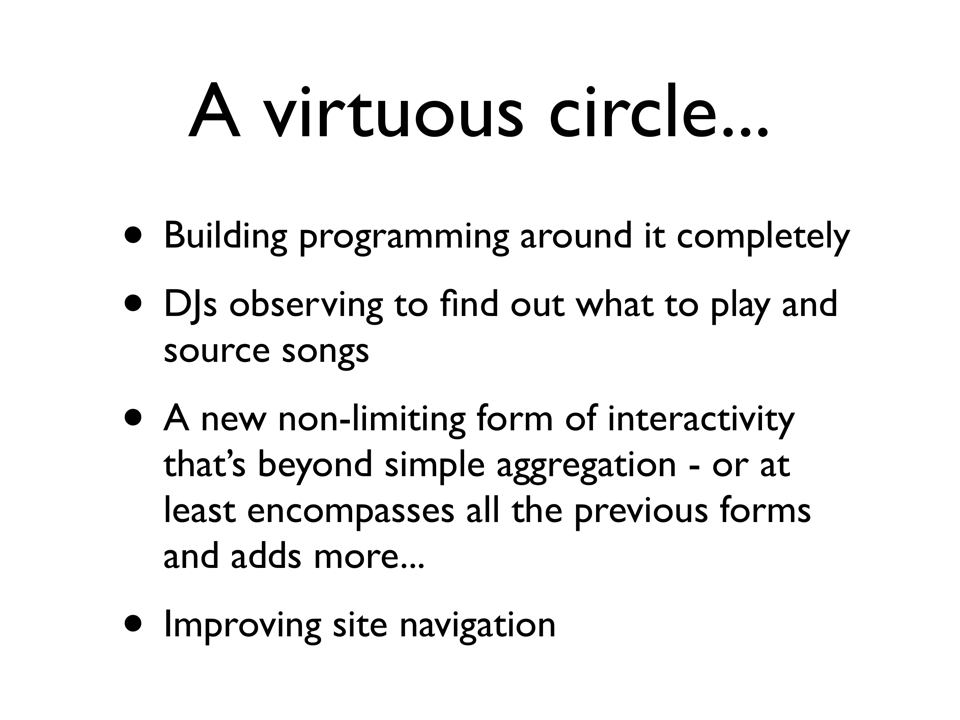
we could build programming about it completely we could do an entire set of um radio which is based on over-the-week sent text-in rate your songs you hear over the week we'll play the best rated ones or we'll do things around themes you know text in summer any song you think is particularly summery so songs that come out of that a lot we'll have a summer theme that'll work alongside that one the DJs can actually watch this in real-time they can respond to it in real-time if a song's not going down well if a network can see people aren't enjoying that song or or better actually for the BBC if it's really divided if a if some people really like it and some people really hate it cause that gives that's kinda actually more interesting uh you're doing you're kinda doing a more kinda public service reema if you're exploring kind of the songs that are causing people to reinvestigate their own prejudices and think about what they what else they might like that's quite cool and this is a whole thing's kind of wrapped around this idea of kind of non-limiting interactivity that we get information and data in useful kind of this intermediary layer operates around whole different kinds of levels we can do different things with it depending on whatever do whatever we want with it is the point. 00:27:26-0
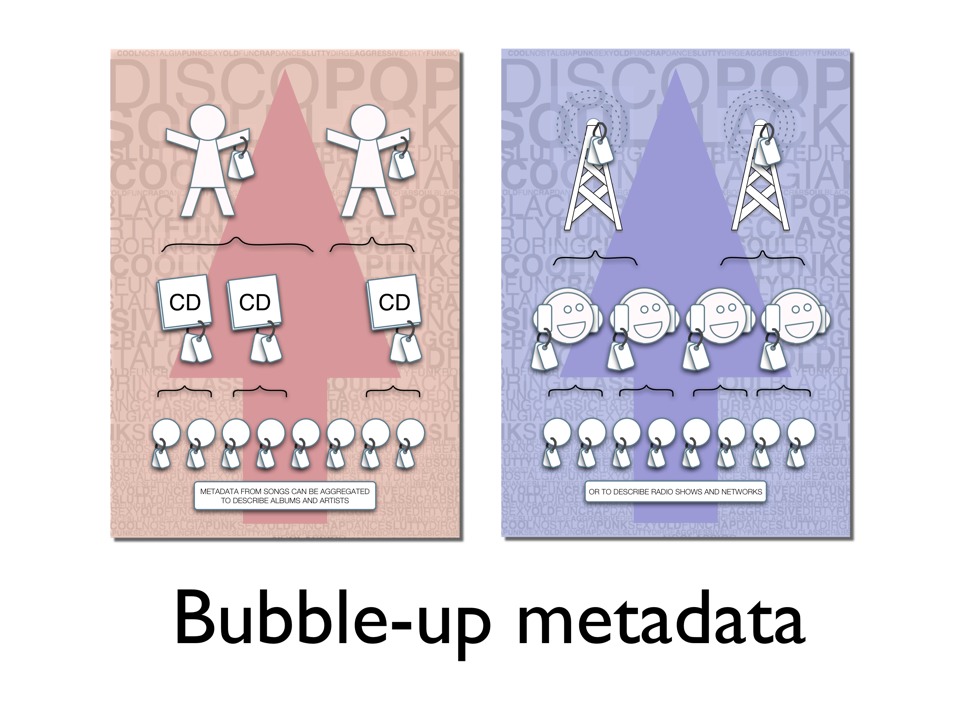
I think one of the most interesting ones here is that we can even do things completely distinct from the radio we can use it to improve site navigation all across the BBC this is I think one of the nicest concepts that we came out came out of from this project was this kind of bubble-up metadata 00:27:39-4
Fundamentally what we're talking about here is that if you do something like delicious or flickr style tagging at the level of the smallest component part so this case a song uh anything that can be aggregated or built up then you can actually start spreading that meaning up through the chain so at the left there you songs at the bottom and a CD is nothing but a collection of songs artists are actually nothings but collections nothing but collections of songs albums whatever so if all the songs is one artist are country or badger or potato then uh the album too will be potato-ish and the artist too can be can reflect that potatine quality um similarly in terms of the radio networks a show can be kind of considered an aggregation of songs uh and so that that show can capture all the tags associated with those songs and be considered be described in those ways so that means we can start doing things like if you liked this song you might like this artist you might like this show you might like this network you might like this other song and that this kind of nice kind of really nice kind of pattern of movement around this kind of space gives you a much whole range of different ways of navigating this kind of environment. 00:28:44-3
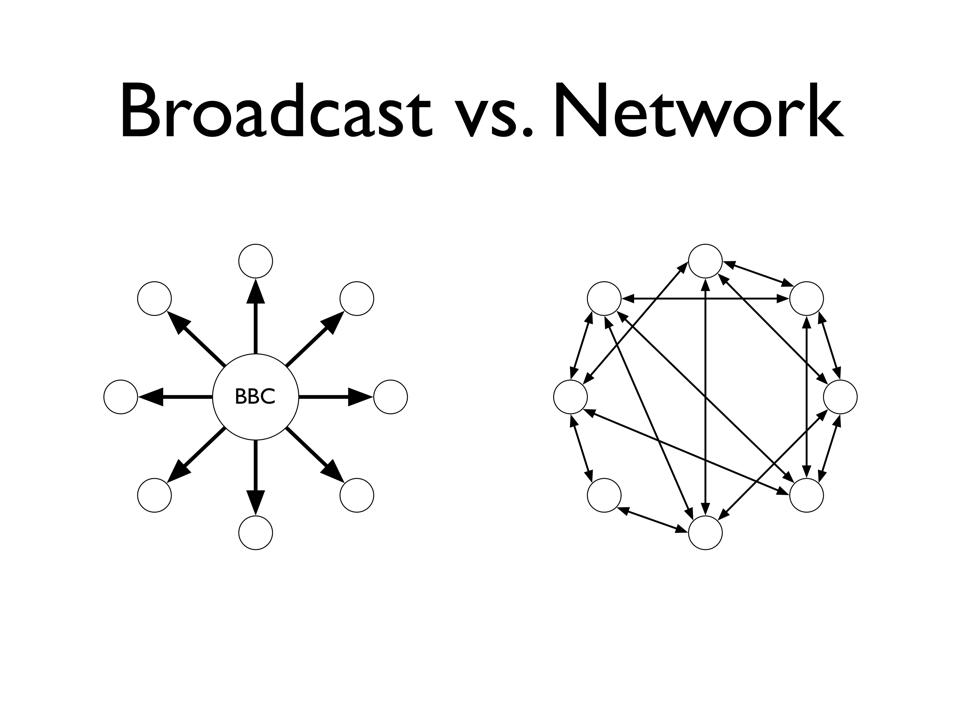
so that was phonetags and um as I say at the end of the presentation the URL will be out you can play and explore that this concept of broadcast network again I mean Phonetags was about creating better mediation trying to you know wrapping the BBC in cotton wool so it played nicely with the other kinda but the other side of this one is the peers kind of talking to each other better and we came up with a project during this one which is called group listening 00:29:07-5
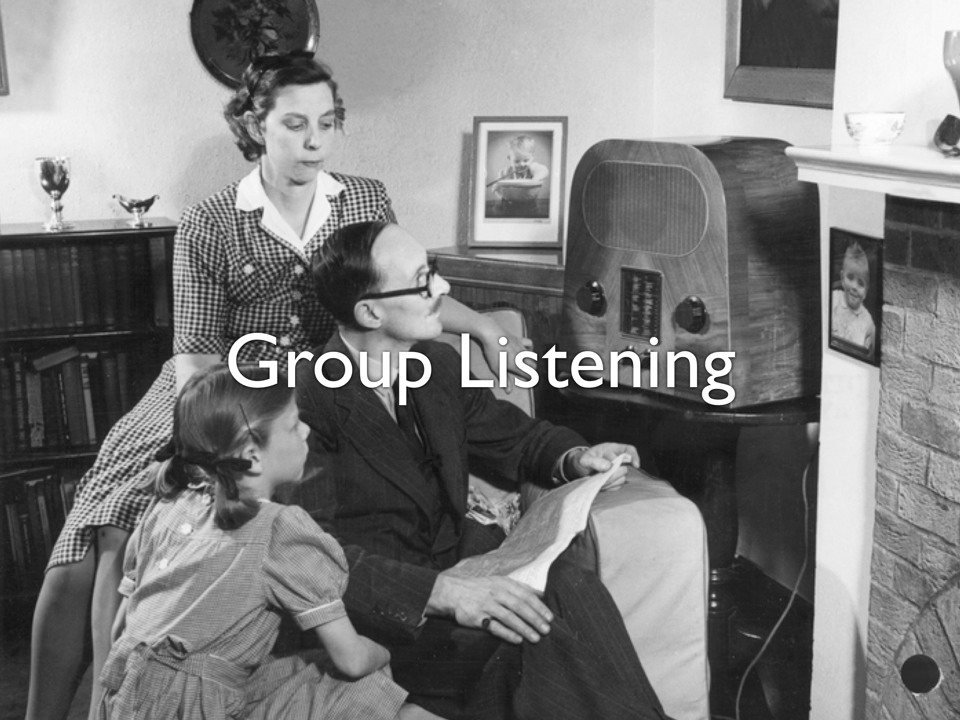
so okay this is a typical english family I think this last week at my mum's that's me in the back with the hair mr webbs there staring at the radio and that's paul hammond in the front with the pigtails say hi paul heh hehehe um I think I mean for us one of the most important parts of this picture I mean it's not about this picture this picture is an illustration it's that you know in the old days people used to sit around and listen to media together you know there was a always been a social aspect to consuming media listening to media or whatever this kind of concept that the radio or television is the hearth in the home is you know kind of well known although I think kind of ebbing a bit people nowadays I think kids nowadays not quite so familiar with that concept as they might have been once I think it's pretty clear there's been a move away from this kind of shared experience both radio televisions they become cheaper more portable people have them one in every room alongside that one there enourmous numbers of niche channels on every subject uh so people have kind of split apart that kind of idea of the family unit as a kind of mutual viewing organ is kind of mm how nasty image sorry has kind of gone a bit wrong 00:30:18-4
um uh okay so uh heh god I find myself funny sometimes okay um anyway while all this aggregation is happening there's also still been this kind of common human need to actually chat and engage around media I mean you only really have to look at kind of people used to talk about water cooler moments but you know and they still do actually they still do talk about that they still talk about desperate housewives or something or sports on television or radio is a really good example of things that people really think they feel in a really communal social way um online ever since usenet kind of turned up first alt.tv groups appeared then like insane nutters talking about E.R. all day who have kind of had fun with each other and I used to be one of those um uh people have been trying to find other people to share those communal experiences with either their friends or family or interest groups and these are normally experiences not met by their immediate family um so we can relate that the concept for us was like how do we try and get some of that social aspect back into watching or listening to media in the kind of useful way that really kind of reflects the times and isn't kind of dumb doesn't restrict you to kind of sitting there embarrassed in a room with your mother while someone has sex on television #00:31:29-4#
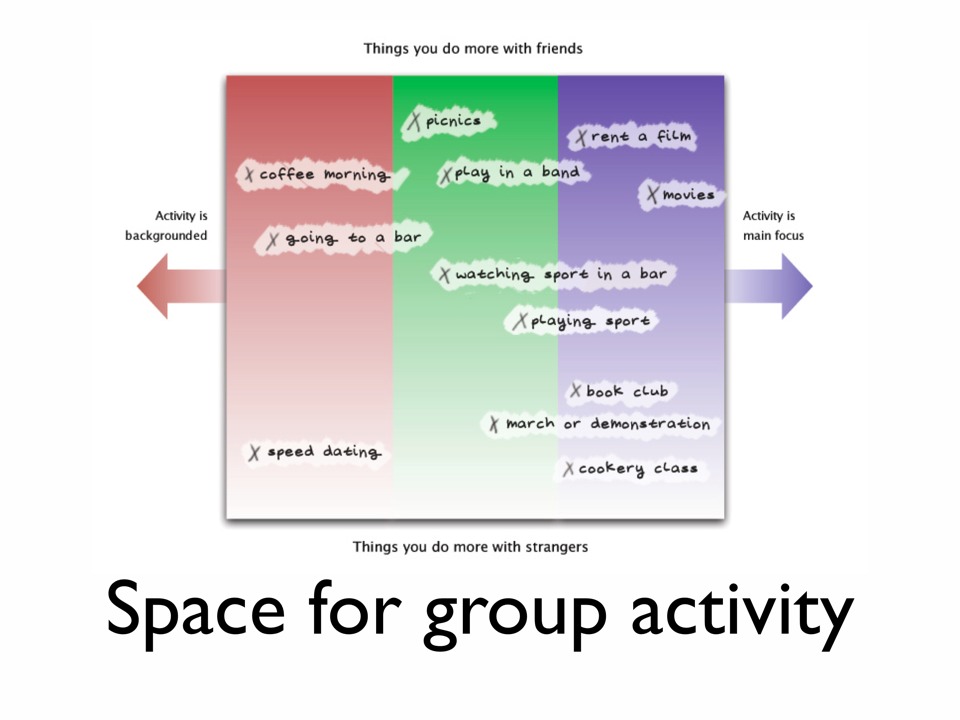
um so I mean this is one of those interesting diagrams we've done over the time we've been together working together this is kind of space for group activity we call this one and this is kind of attempt for us to map the things that people do together in to some kind of useful space so at the top there you've got things you do more with friends and at the bottom you'things you do more with strangers um so at teh top there youv'e got like going for a picnic or a coffee mornig or renting a film or whatever so they're things you do with friends at teh bottom things like uh going to a cookery class going on a political march you know or speed dating these are things you do with strangers for the most part on the right there you have things where an activity is the main focus so it's not about talking is what we're saying here and on the left it's things that are mainly about talking or an excuse for talking
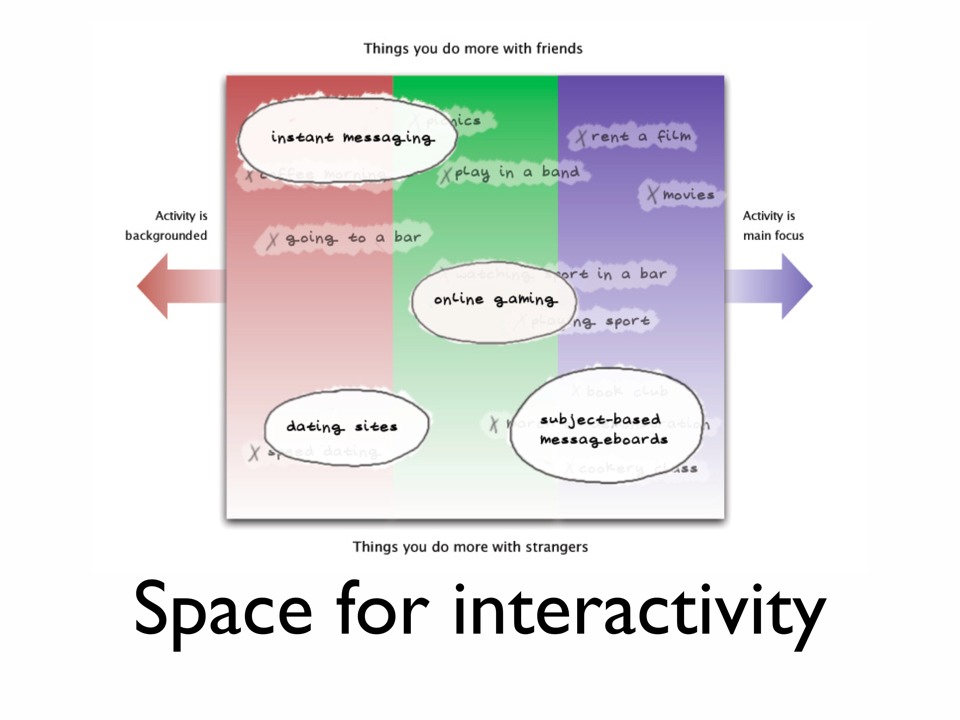
um so what we did we tried to kind of translate these things into an online environment see what teh correlation for this would be online so this is kind fo roughly what we came up with and the core of this one is it's mostly focused in the top left and the bottom right I meant here's this thing of online gaming which is growing really rapidly in the middle which is really important but in terms of things you do with your friends you tend to do those its more explicit chatting around nothing you know it's just interaction with one another and things you do with strangers its online in message board subject-base ddiscussion the socializing aspect is sort of backgrounded the talking about something is core #00:32:48-9#
and that's really interesting to us I mean with us there's kinda big absences and gaps I think that was the two things we noticed there was big absences and gaps and there was very there was much less variation in the kinds of things people were talking about doing so there's like maybe like four or fie things there's four or five things enourmous gaps in the top right things you might actually do with your friends other than talk to them #00:33:08-2#
so this is like an uh an interesting area to explore you see and going back to that previous idea about social media that sort of idea of renting a film whats the equivalent of renting a film online what kind of engagement of going to the cinema of watching a tv program or listening to the radio together might might you want to do and you know you think it'd be an obvious area to explore and with the except of things like social networking maybe maybe flickr to an extent you know you know thsoe social sharing things you know not a lot happening there
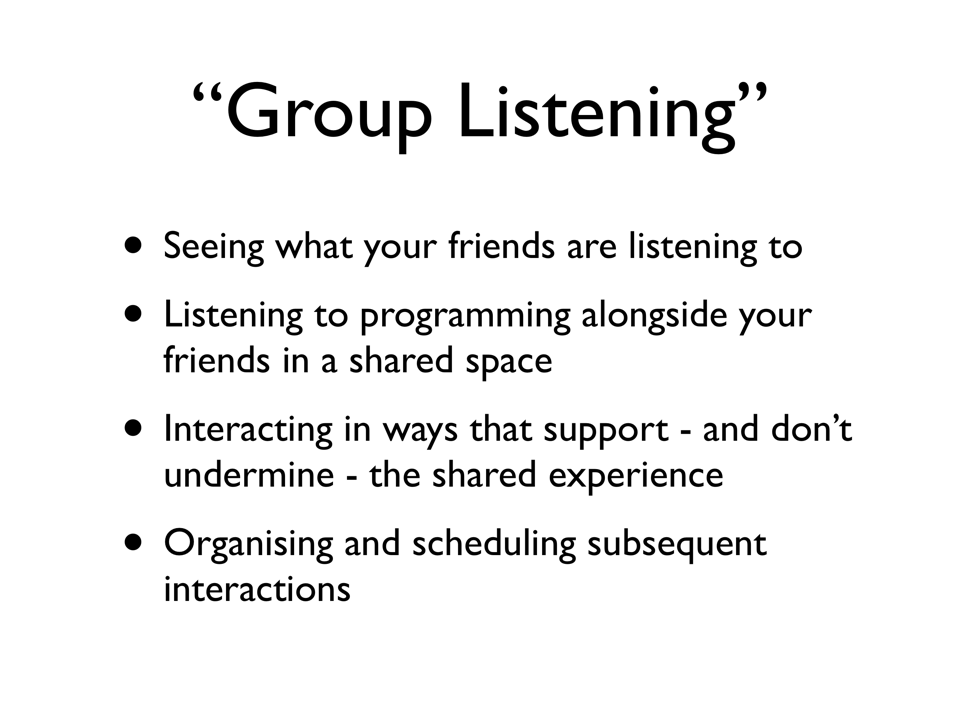
so this is the concept we came up with it's called group listening and um it's really kind of four parts that you should be able to see what your friends are listening to obviously we're radio people so this is mainly audio #00:33:46-4#
um that you should find a way to listen to programming alongside your friends in some kind of shared space that you should be able to interact around that programming in ways that didn't kind of well interfere with teh epsxerience so that could be #00:34:00-1#
different expreiences for like a sports program or a discussion program and uh you should be able to prgajnize amdn schedule subsequent interactions in one way or another that so that kind of participation should work really well #00:34:10-7#
we got this prototype again which will be online you can play with I think the most important thing about the prototype I'm gonna show you here is that it's it's again it's one of teh things we do in the department in order to get a point across it articulates to people much better than the powerpoint presentation does intereswtingly what we're trying to acheieve what we're trying to get towards it looks a bit sparse but it should be indicative of what we're trying to talk about #00:34:33-8#
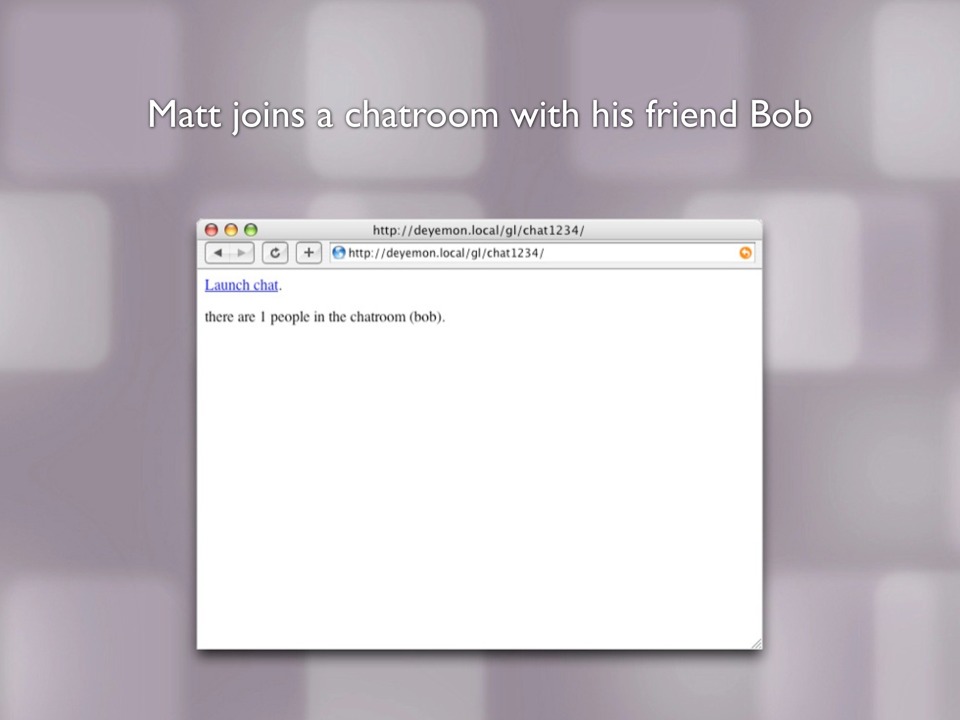
so here we are
matt joins a chat room with his friend bob
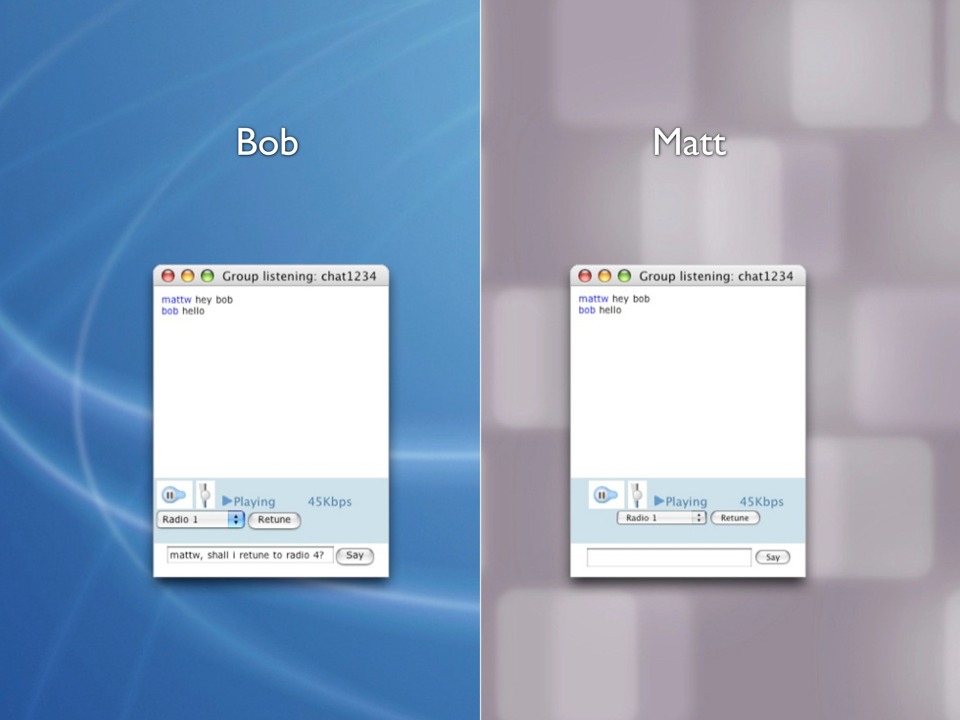
um and here they are in their respective chat rooms bob and matt I would suggest you know it's easier if you follow one of them it makes more sense if you follow one of their paths in this one #00:34:46-8#
so like you get into the chat room and they're both actually immediately listening to teh radio you can see the bottom there they're listening to radio 1 both of them they're the chat room includes a kind of realaudio stream and it's just playing for both of them they can chat around that and engage with that as as and how they want #00:35:03-0#
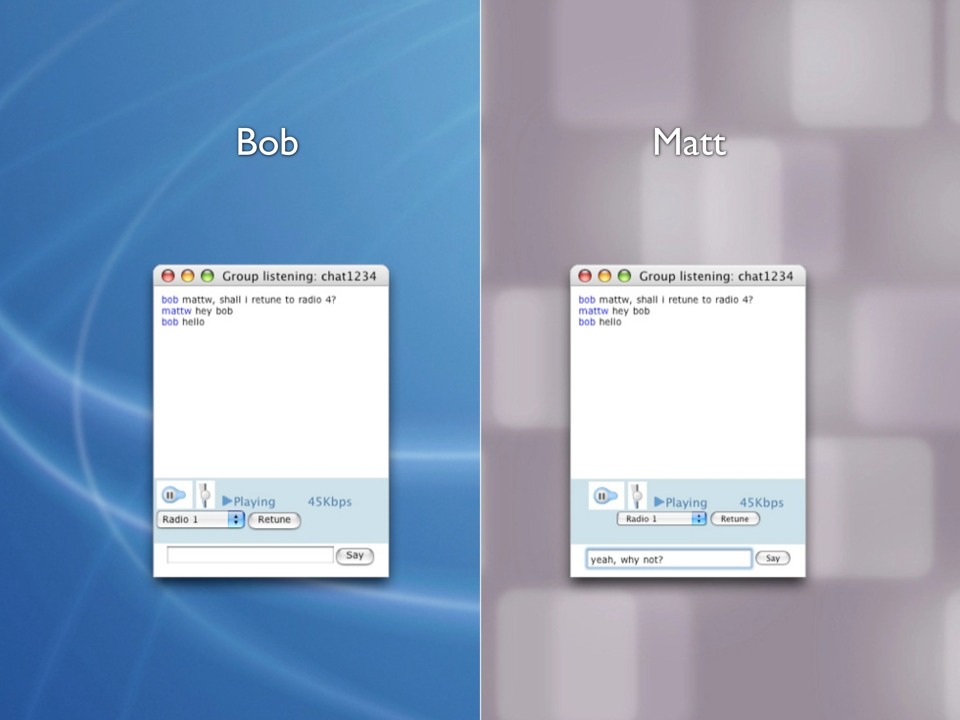
bob says bob tires of pop music #00:35:03-6#
wishes for more erudite material so says lets listen to radio four matt's comfortable with that
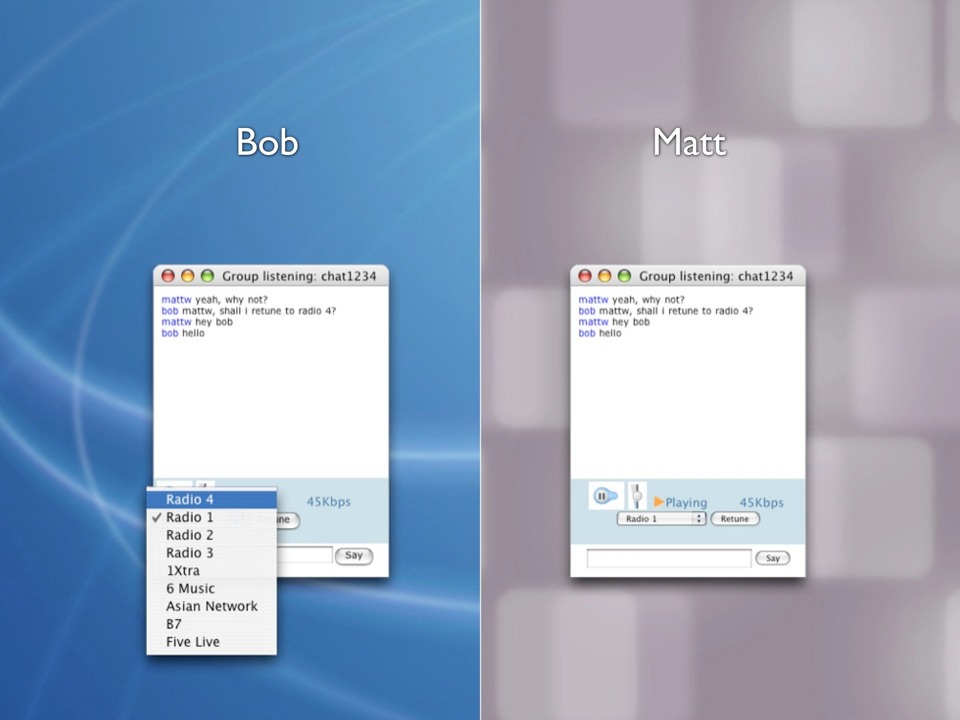
bob selects radio 4 on his machine on his console and it switches to radio 4 on both of them
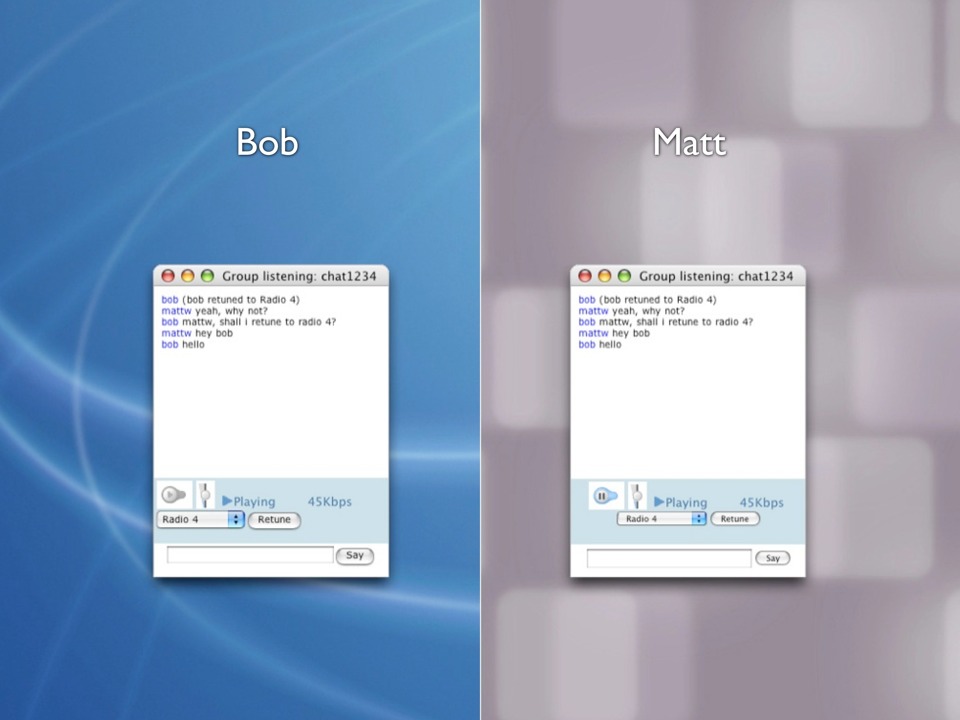
so now so that kind of just that idea of kind of collaboratively tuning that two people in different spaces can tune a radio together and still talk about it as if they were in teh same place talking about it #00:35:24-1#
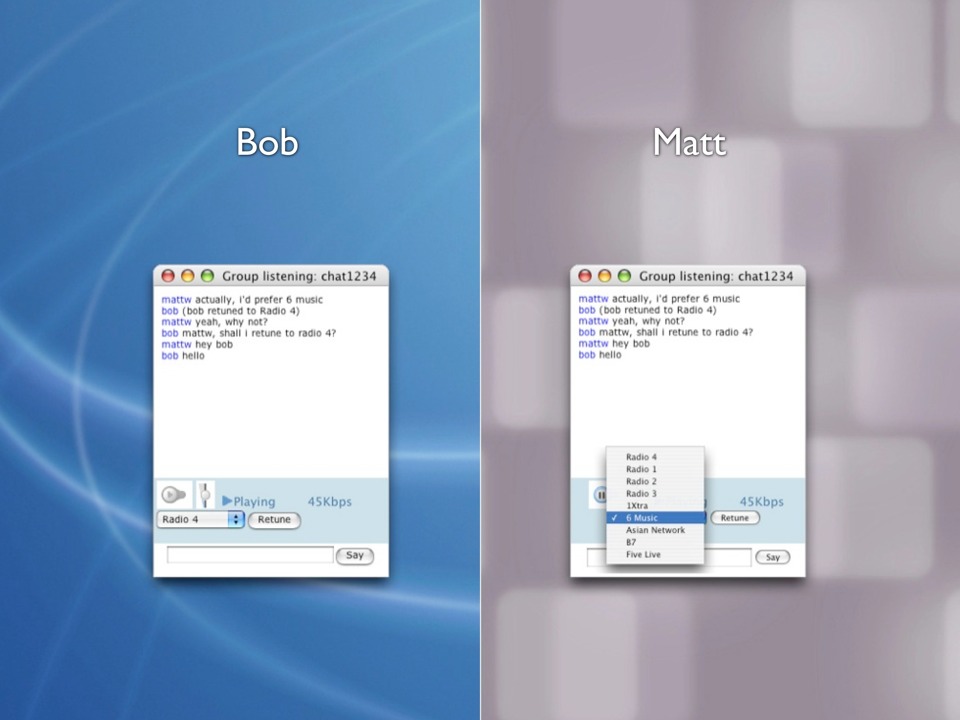
uh matt typically you know never one for erudite materials sorry old chap switches to 6 music wants a bit of rock
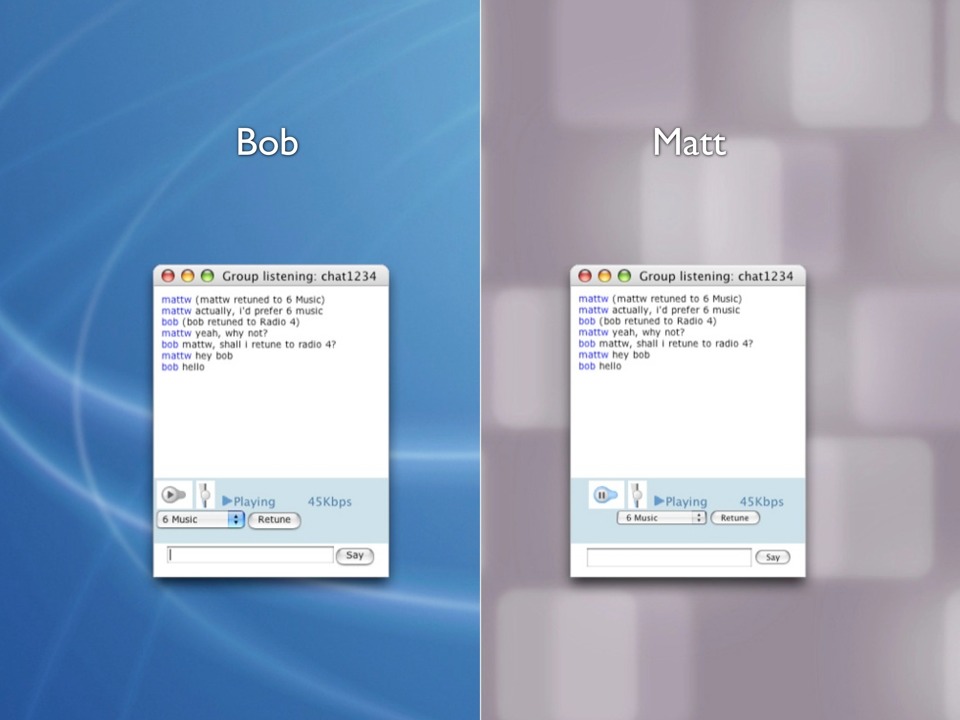
and there they are um now listening to rock both of them listening to 6 music
that's that that's basically the demo and it's online adn we'll and we'll give you the url in a minute you can have a play with it uh seems kind of simple seems kind of sparse but I think the endgame for us is kind of you know look what we've got this is a mockup of the radio player you know it's as paul said four million hours of on-demand radio adn six million of live and an enourgmous number of users people do this kind of stuff it's great because it has some of those affordances as the web it allows you to navigate through programming usefully it allows you to find things and bookmark them and address them and use them but it doesn't have the other affordances you expect to from a network it doesn't connect you to pepole in any way
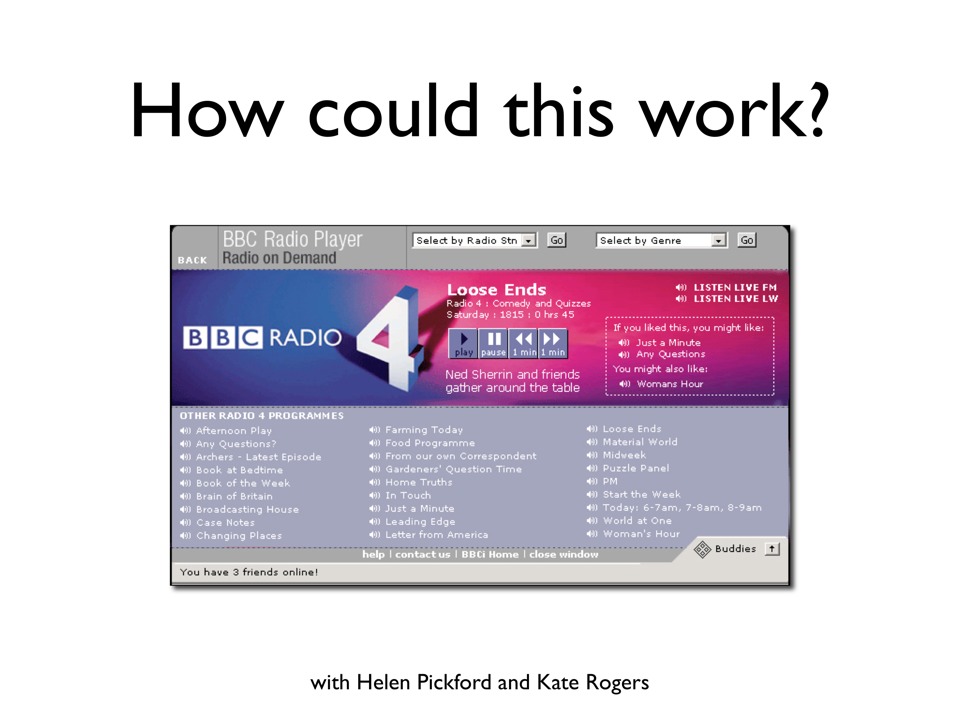
so here with us is a mckup we've got a thing at the bototom for friends of buddies
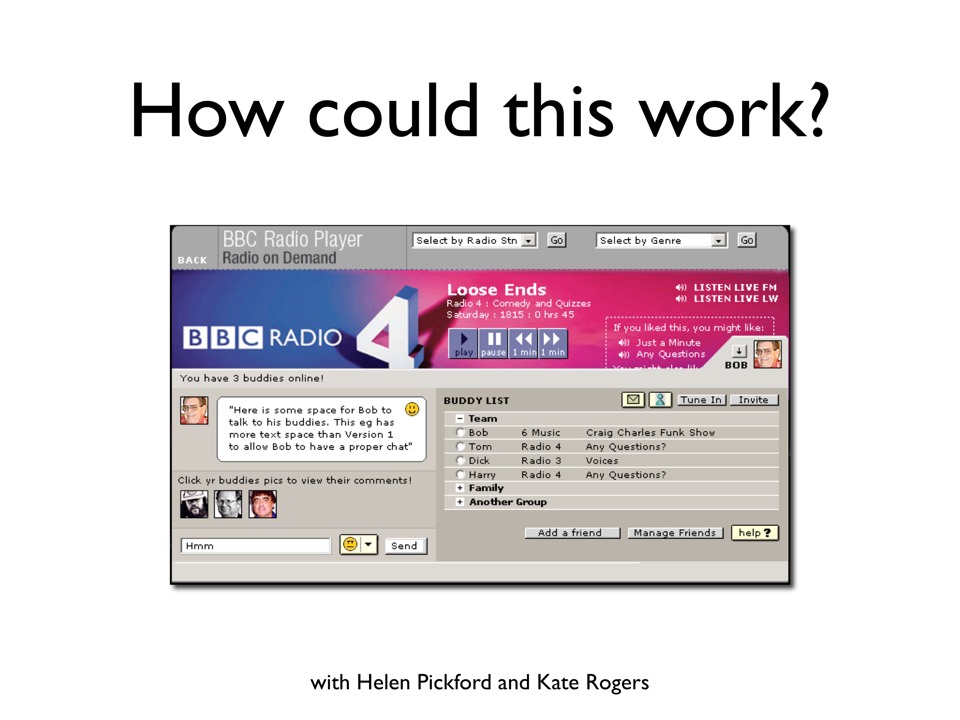
and you pop itup and there are ways of interacting around the rpgram you can see what theyy're doing you can invite them into a programme and engage them #00:36:21-5#
now there's all kind of ways you can engage around this kind of stuff and I'm were're not really here to shut this one down yet this is kind of rfairly early peiece of wortk or thinking for us but um you know again this idea of you know of being appropriate for the meidum in terms of a radio player in terms of audio we talked earlier about how it could be background how it suites multitasking so we have to find a away of engaging that suites multitaksing so imagine you're at work and you're listening to the radio and you're working on a document uh and then you hear something that is really amusing and you want to kind of register that to your friends who are also working somewhere else working on a document #00:36:56-2#
maybe the best way to do that would be through some kind of noise signal they're already listening on that channel of a noise of engagement in the ear you know maybe you want to kind of use that space in some way so to register kind of applause or to say this is a good song or to to have some kind of noise that indicates agreement or disagreement #00:37:12-4#
on the other hand maybe you want a more overt kind of kind of discussion if it's a kind of if it's a sporting event and you want to respond to things as a real kind of lean forward focus kind of engagement then you maybe you want to put in a chat room an overt chat room or you want to pass people off into another media I think I mean that kind of whole area around this is really interesting for us that that you media listening to and consuming media a shared experience and you find ways of making that experience appropriate to what you're watching or listening to #00:37:42-6#
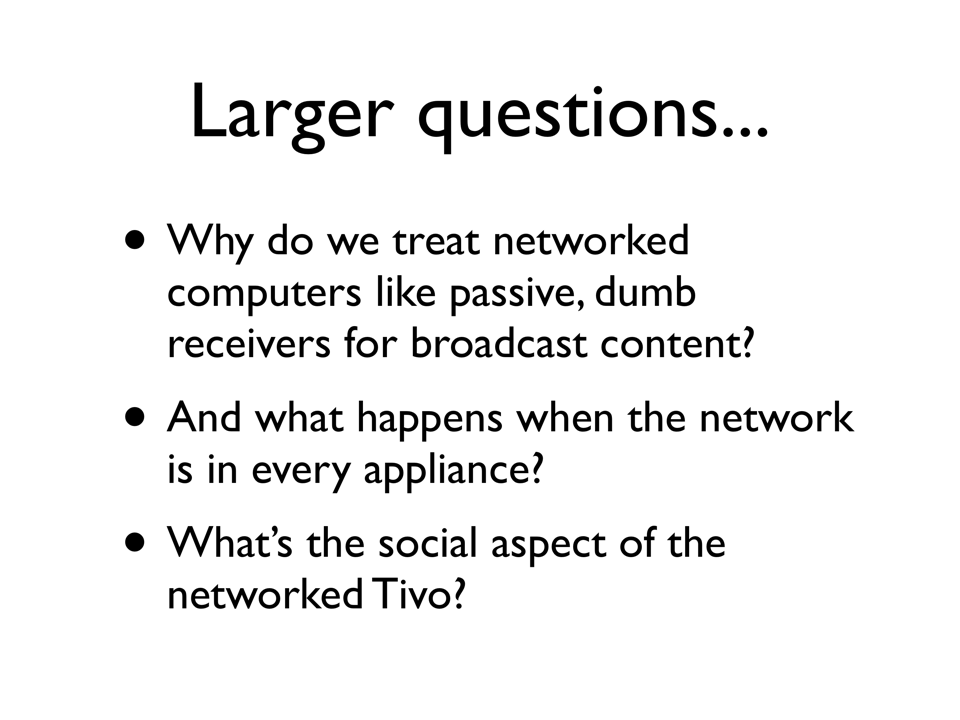
now again tihs is like really early work for us and we're kind of just stepping off in the right direction but it's already opened up for us some really large and interesting questions which we're excited by and here are some of them which is like #00:37:53-2#
why do we treat networked computers like passive dumb receivers for broadcast content? we don't need to there's simply no need they could be much more rich they could be much more social quicktime realplayer they could be much more socially useful engaged kind of things #00:38:08-1#
um and I think it this just kind of pushes you forward if you think about it logically we're not that far away from networked enabled devices in every home so kind of that software being on your television your tivo whatever what would it be like to have a socially enabled tivo a really richly socially enabled tivo which allowed you to watch or listen to things with your friends at a distance and engage around it with them #00:38:30-4#
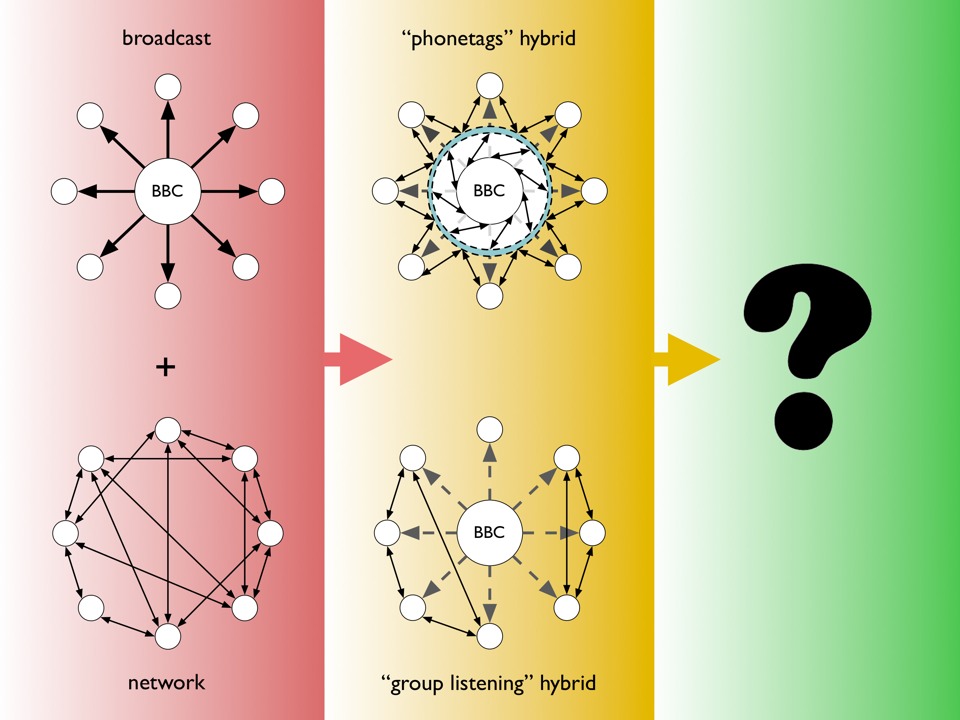
um so that's where we're going to basically end and this is kind of you know uh a fun diagram that we knocked up to kind of suggest like how you might represent some of these kind of hybridized structures these kind of mixtures between broadcast and network
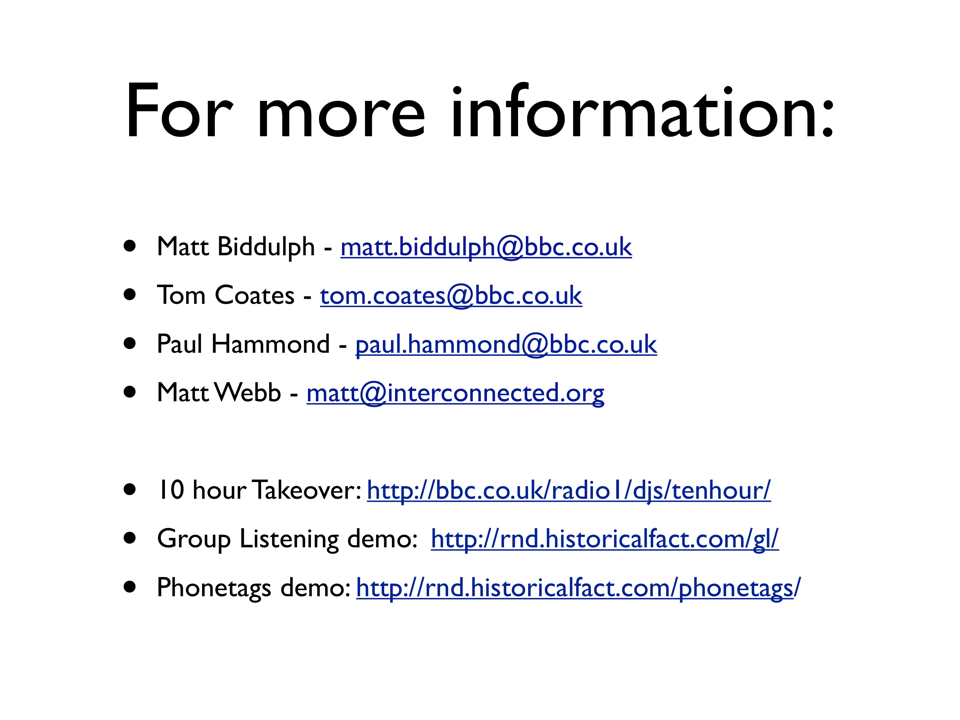
uh and here are our names and that's where the demos are are they working demos? #00:38:49-3#
uhhh almost #00:38:49-3#
the demos are almost working um so but they will be kind of in the next twenty minutes or so right #00:38:56-9#
yeah #00:39:02-0#
we should probably wind up now I think the next peopel have to come up uh thanks very much #00:39:07-4#
Commentary
Something something something, any traditional broadcast-style medium would benefit from exploring interactivity and social construction in this manner, including newspapers (as I talked about in the socialization portion of my Little Printer design analysis) and book publishing, etc., etc., more later.
I’m Vitorio, it’s February 21, 2011 and I am completely ashamed for putting this up only half-finished, but I really need to pack. Tweet